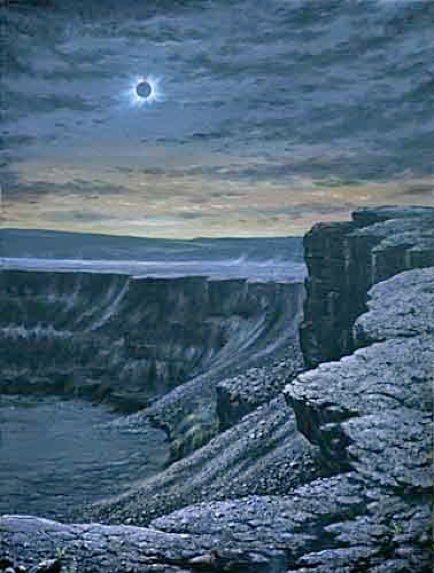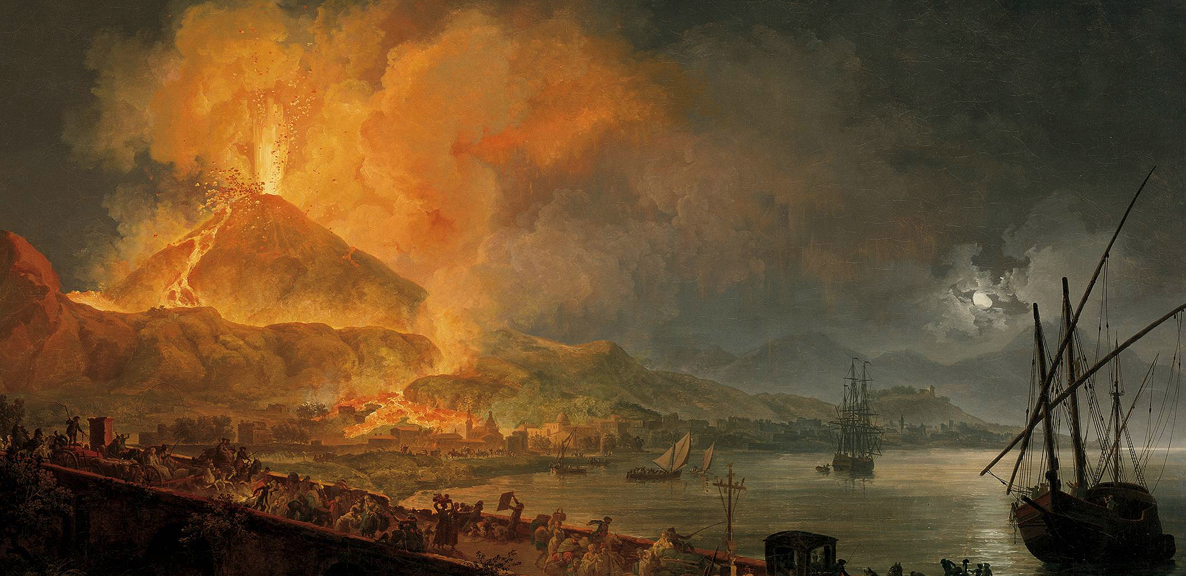
Living Dangerously on the Slopes of a Volcano
For believe me: the secret for harvesting from existence the greatest fruitfulness and the greatest enjoyment is—to live dangerously! Build your cities on the slopes of Vesuvius!
Friedrich Nietzsche,The Joyful Science, §283
The 2018 Eruption of Kīlauea
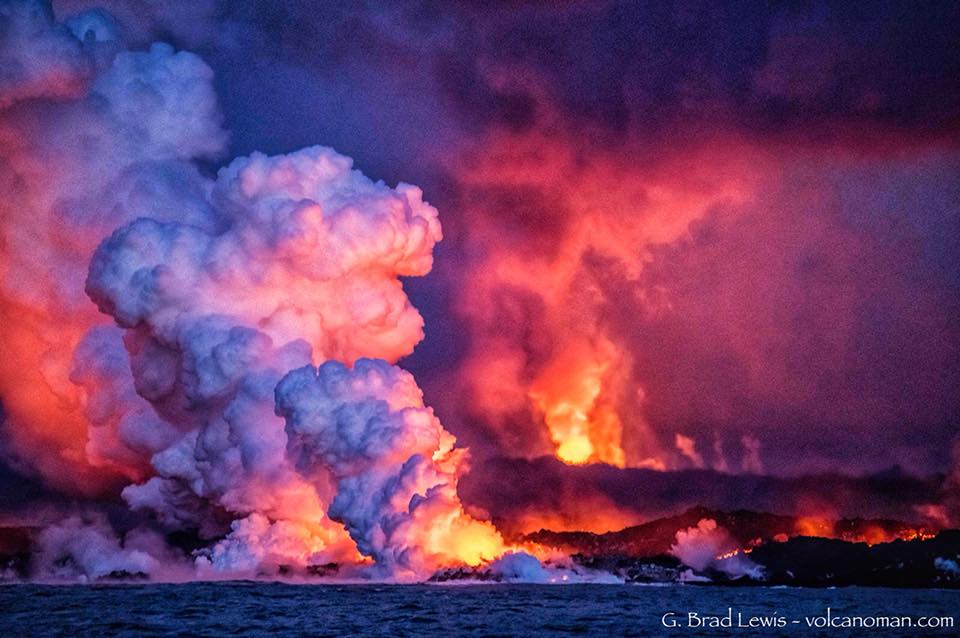
Mai Kaua'i nui a Oahu, a Moloka'i,
Lana'i a Kanaloa, mai Maui a Hawaii,
Ka Wahine — O Pele —i hi'a i kana ahi
A á pulupulu, kukuni, wela ka lani:
He uwila ku'i no ka honua;
Hekili pa'apa'ina i ke ao;
Pohaku puoho, lele iluna;
Opa'ipa'i wale ka Mauna;
Pipili ka lani, pa'a iä moku.
Nalo Hawaii i ka uahi a ka Wahine,
I ka lili a ke Akua.
From famed Kaua'i to Oahu;
Thence on to Mother Hina's isle;
To Lana'i of Kanaloa;
To Maui and, last, to Hawaii:
This the route of the Woman — Pele.
Then she rubs her fire-sticks to a blaze:
Up flames her touchwood, kindling the heavens.
Earth sees the flash of lightning, hears the boom
Of thunder echoed by mountain walls —
Rocks flung in space bombard the day,
Shaking the mountain to its base.
The firmament sags, clings to the earth;
Hawaii is lost in Her smoke,
At the passion-heat of the Goddess.
Pele and Hiiaka: A Myth from Hawaii,
Nathaniel B. Emerson 1915
It is now the 11th week of the eruption of Kīlauea volcano on the Big Island of Hawaiʻi. At the end of April the geologists at the Hawaiian Volcano Observatory had warned that something was about to happen. The lava lake in the vent in the Halemaʻumaʻu crater at the summit had risen to the highest point it had been since the summit eruption began ten years ago. The Puʻu Oʻo cone down the east rift zone about ten miles, from which lava has been continuously erupting since 1983, was also full of lava and scientists had begun to observe increased seismicity and ground cracking in the area. On the last day of April the floor of Puʻu Oʻo collapsed and just about everyone on the Big Island knew that an eruption was imminent. Something like this had happened several times in previous years though. A few years ago I was driving with my friend down the highway and we saw the eruption explode from the flanks of Puʻu Oʻo. But this time there was a sense that something was different. The lava in the summit crater had never been this high.
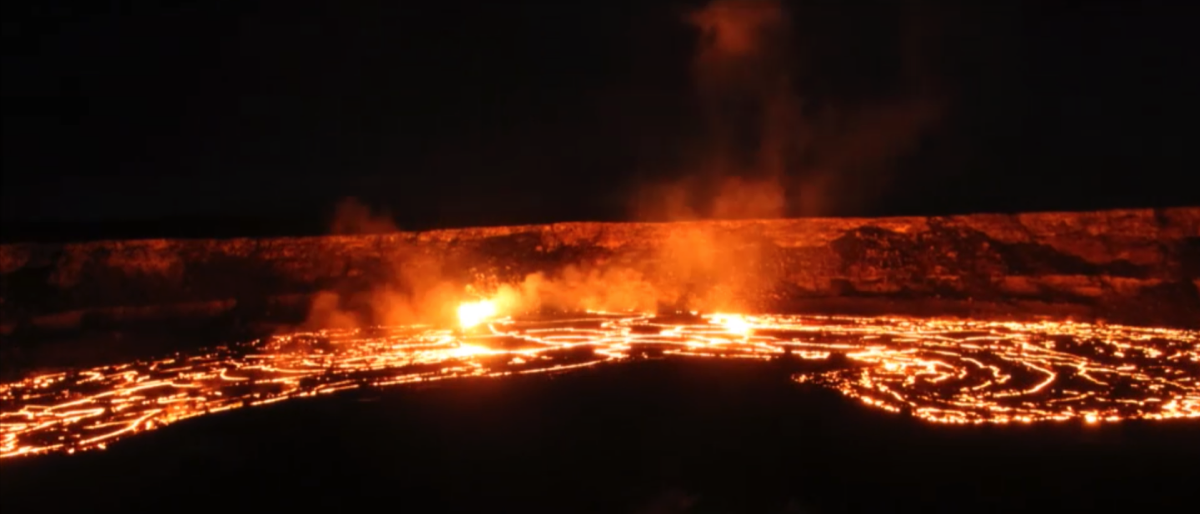
Lava overflows on the floor Halemaʻumaʻu Crater, April 25, 2018. Image from USGS video.
And soon, within hours of the Puʻu Oʻo collapse, the lava in the vent within Halemaʻumaʻu began to recede. We really had enjoyed seeing the lava at the summit in recent years. Great crowds of people gathered at the observation deck outside the observatory to watch the lava dance, spattering and splashing in incandescent splendor against the darkness of night. Over the next couple of days the lava receded further than it had in several years and I knew that this was something different. Kīlauea has had the reputation of being a somewhat gentle volcano, its effusive eruptions down the rift zone over the years, and the fiery glow from the lava lake at the summit, drew awe-struck spectators from around the world. I live only two miles from the summit, actually just a few feet above the summit on the flank of Mauna Loa. It was always fun to hike from my house to the summit observatory to take in the incredible view and listen to the excited chatter in so many different languages. As long as there was some lava draining out from the Puʻu Oʻo vent below, and the lava lake in Halemaʻumaʻu was relatively stable, there was nothing really to worry about. The lava lake, which had opened up at the summit in an explosive eruption in 2008, would rise and fall periodically. For the first few years after the summit vent opened, one could only see the glow from the lava down in the vent. Then over the years the vent widened considerably, and finally in May of 2015 the lava rose high enough to be viewed from the summit observatory. It was nothing fearful. There have been lava lakes at the summit several times in last couple hundred years. Mark Twain wrote about it when he was here. We used to long to see something like that in the years before the 2008 eruption when there was just the peaceful summit landscape to marvel at. Everyone was thus really excited to finally see lava at the summit. We even had hopes of one day seeing something like the 2000' ft high fountains of lava that occurred during the 1959 Kīlauea Iki eruption and for a few years after the 1983 eruption of Puʻu Oʻo. For much of last year the lava at the summit had dropped a bit so one could only see the glow from the observatory. Then this year the lava lake rose again high enough to be visible. At the end of April when the lava began to overflow across the floor of Halemaʻumaʻu again, I went to the summit with a friend visiting from San Francisco and we were just ecstatic to see the fiery spectacle. There was really nothing to fear. People had lived up here for generations experiencing various eruptive phases without any real danger. The area around the summit of Kīlauea has been a really magical place to live, with its cool, clear rarefied high-altitude air, the almost pristine native Hawaiian forest, the beautiful and rare native birds, the dramatic landscape to hike through, it has been my most favorite place I have ever lived.
The only danger, I have long understood, would come not with lava at the summit, but when the lava would fall all the way down completely out of sight. It was not the fiery glow that was dangerous, but rather when the glow disappears. The time to be concerned, I had understood, would be when the lava level receded below the water table. After the Puʻu Oʻo collapse I watched anxiously, through the HVO webcams, as the summit lava lake began to drop. As it dropped further and further each day, further down than it had been since the summit vent had first opened in 2008, I knew this was something different, and with the tremendous volume of lava that was heading down from the summit and the Puʻu Oʻo vent, I knew that this was going to be very interesting—and perhaps even dangerous.
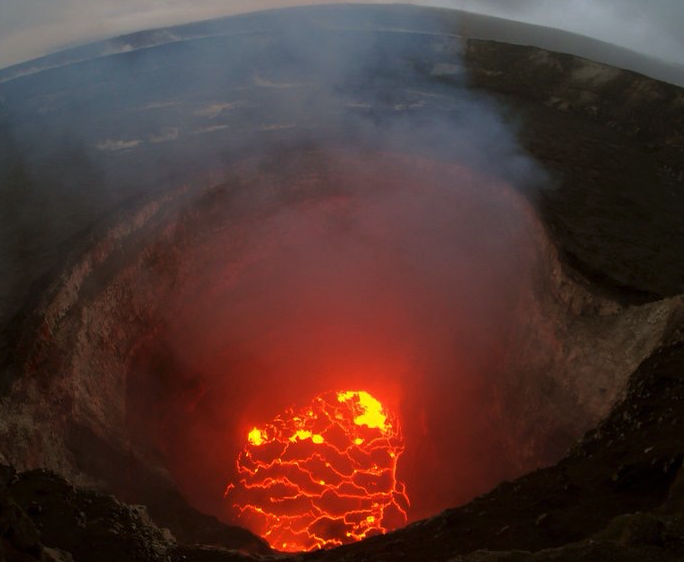
At the beginning of May residents of the Leilani Estates subdivision in the Puna district began to observe roads cracking and steam coming out. One of my students, who lived in the neighborhood, came to my office on Wednesday morning May 2nd, the last day of classes for the spring term. He said he couldn't sleep because he heard the ground cracking underneath his house. It turned out his house was only a couple hundred yards where the most voluminous fissure of lava would soon open up. Finally, around 5:00 pm on May 3rd, a fissure of lava opened up in Leilani and the dramatic eruption of 2018 began. The lava had erupted not where it had been erupting over the past 35 years, but further down the east rift zone where it had last erupted in the 1950s. The area where it erupted had been known to Hawaiians as Keahialaka, which translates as 'the fire of Laka.' Only a few short years after the eruptions in the 50s developers renamed the area Leilani, meaning 'heavenly flowers' and built a subdivision. I believe the Puna district was the fastest growing population in Hawaiʻi in recent years. Land was cheap in paradise. But now lava was erupting right in Leilani Estates. I went down that night to help a friend evacuate. I knew she didn't have a car and might need assistance. She lived just outside Leilani, outside the evacuation zone, but close enough to want to leave. As I was waiting for her to gather her things I stood at the end of the driveway and looked across the road toward where the eruption was happening. I couldn't see or hear anything. It turns out the eruption had briefly paused while I was there. But one could still smell it. I've been close, sometimes probably too close to lava in previous years, and the acrid, pungent odor was quite familiar. It's something one never forgets. Though I couldn't see it or hear anything I knew the lava had erupted just a few hundred yards away. I knew there must be a lot of lava coming so I was definitely a bit apprehensive standing there. I wondered what was to come and how close the lava would come to this place. I could not have imagined what was to come.
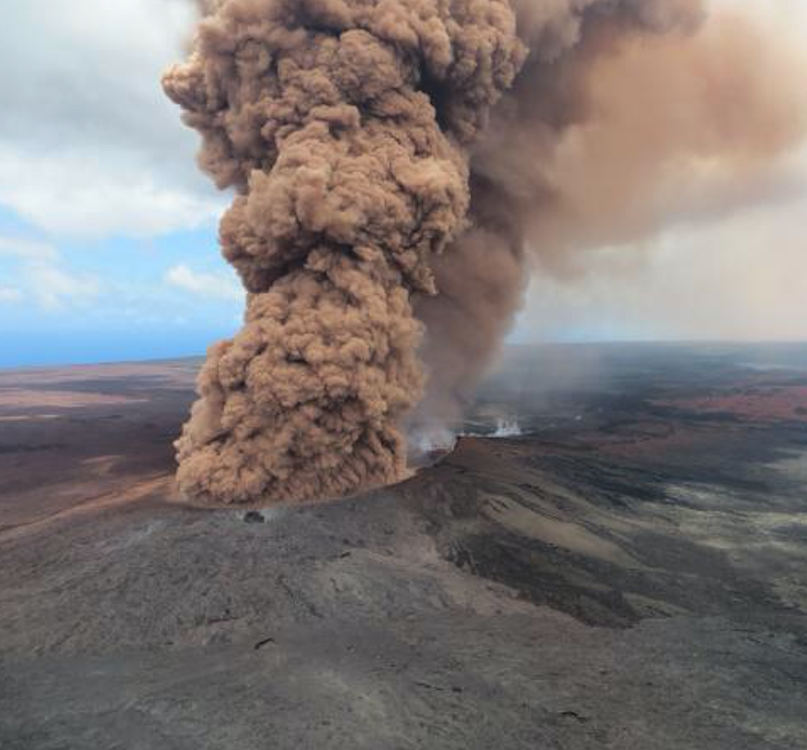
The next day even though classes had ended I had to prepare for final exams the following week and had errands to run in Hilo. I told Keri that she could come with me to Hilo if she wanted, but that she might really enjoy the peace and quiet of Volcano if she wanted to stay at my house. I live at the top of the neighborhood, just about 4015' elevation. There are no houses between my place and the summit of Mauna Loa in the far distance. My study upstairs has a lovely view into the forest. I was in my campus office in Hilo preparing final exams when the first earthquake struck at about 10:30 am. It was a pretty good jolt, a 5.0 quake that shook the building. It was the strongest quake I had felt in several years. I took a break and went to lunch and was sitting in my parked car when the big quake struck at 12:46 pm. It measured 6.9 and shook the whole island. A huge column of reddish-brown ash rose from Puʻu Oʻo and streaked across the sky. It was by far the strongest quake I've ever felt, but sitting in my car in Hilo I didn't feel it nearly as strongly as Keri felt it at my house. She sent me a photo of some of my ceramic vessels, the few that I hadn't packed away the previous week, all tumbled over on the display case, but somehow, miraculously not broken.
In the first few weeks of the eruptions in early May numerous fissures of lava opened up along the lower east rift zone. Hundreds of people were forced to evacuate their homes and many houses in Leilani Estates and surrounding areas were lost to the lava. These early fissures did not produce channelized lava flows however. Geologists explained that the chemical composition of the lava indicated that it was not fresh lava from the Puʻu Oʻo and summit vents, but rather lava that had been stored all these years below the ground in the lower east rift zone from the eruptions in the 1950s and 60s. In late 59 a lava lake had formed in Kīlauea Iki and had drained out and then three weeks later lava erupted in the Kapoho area of lower Puna, destroying a little town that had been there. So I knew that the fresh lava was still on the way and that there would be lots of it.
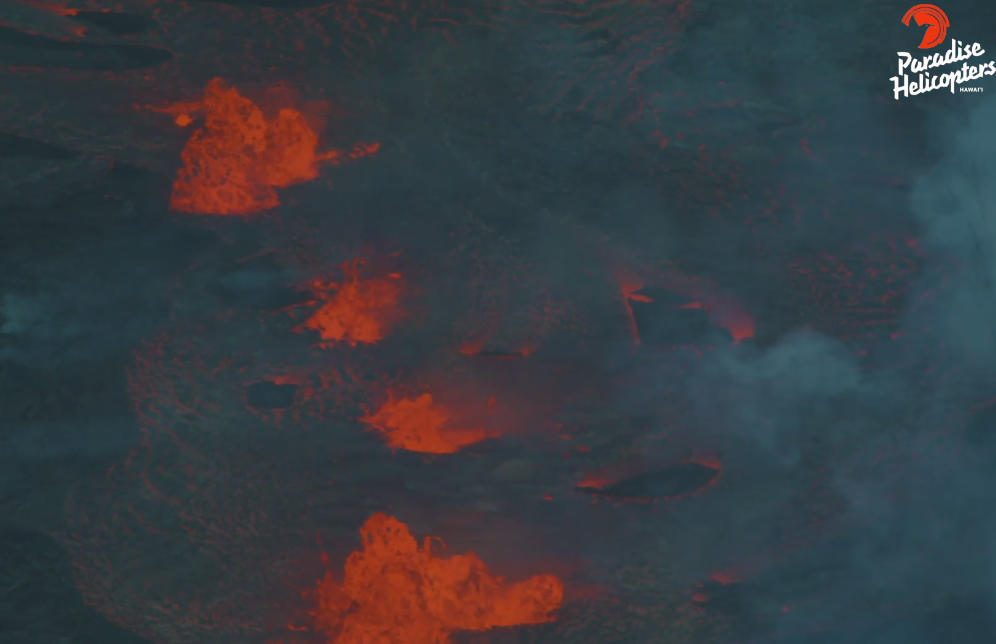
There was a big meeting in the National Park visitor center on May 9, the night before they closed the Park, with HVO scientists and National Park officials explaining the situation as best they could. The scientists explained to us that we were entering a period where explosive eruptions at the summit were likely. As the column of lava receded the walls of the vent would collapse inward, sending upwards a plume of ash and smoke. Eventually the vent would get plugged and then the steam from the lava interacting with the water would build up pressure eventually resulting in an explosion, and greater columns of ash rising in the sky. These would be greater explosions than what resulted from the rock-fall events; however, we were assured it not really a danger to the surrounding community, as the only likely impacts would be a little ash-fall. The 1924 explosions did eject "refrigerator sized boulders" we were told, but these did not land far from Halemaʻumaʻu, and even the smaller pebble sized stuff never left the wider caldera. During the questioning period after the geologists had explained all this, I asked about the potential for a bigger, catastrophic explosion. Some years ago I had heard a presentation by lead geologist Don Swanson that despite the recent history of effusive eruptions, there had been large explosions at the summit in its distant history that had produced pyroclastic flows that would essentially wipe out everything at the summit were they to happen today. In responding to my question Swanson acknowledged that he had lectured on that topic in the past, but he assured us, there was simply no evidence to suggest that such an explosion was likely today. I felt a bit reassured, but he didn't elaborate and explain what sort of evidence might lead one to worry about such an explosion to occur.
It is easy to understand the tight spot that the scientists and County civil defense officials are in. The eruption had already started to generate some hysteria, and some mainland sources were warning of catastrophic consequences that were imminent. One hilarious newspaper headline reported it, of "fridge-sized refrigerators" being ejected from the volcano and raining down upon the summit communities. We all laughed at that one, but it was not without some apprehensiveness about what was about to happen. I still had a lot of term papers and final exams to grade and thus spent a few nights in my office on campus in Hilo. Yes, I guess I was a little concerned about what would happen that week and thus I spent the night at a friend's place down on the coast and away from the summit. Thus I wasn't home on the morning of May 15 when the largest explosion at the summit took place.
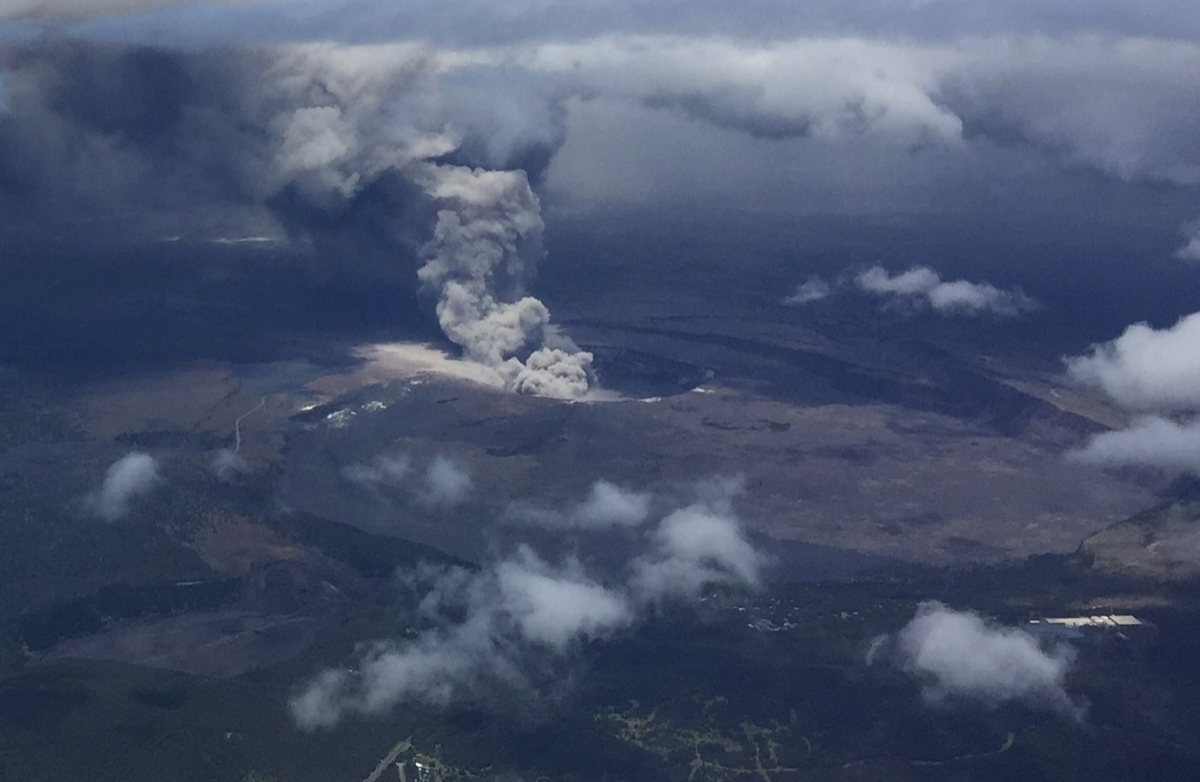
Explosion at the summit on the morning of May 15. Image from USGS.
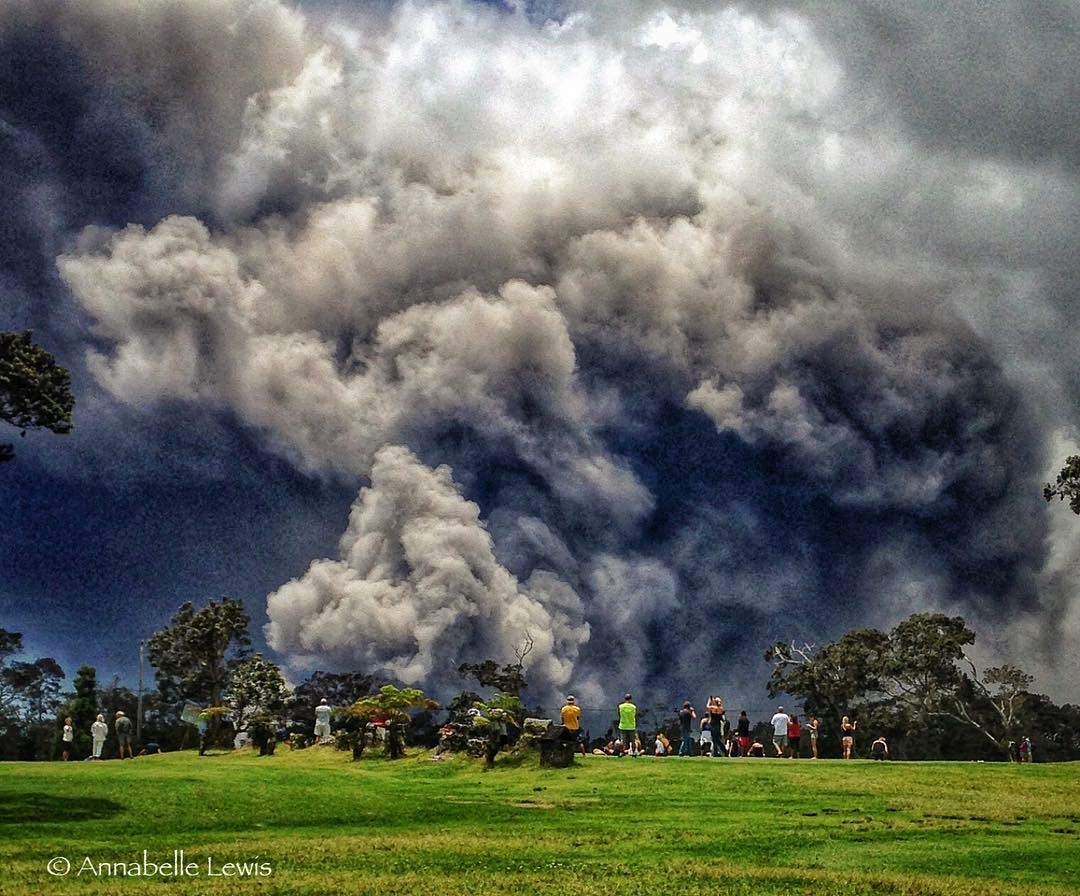
The explosion made headlines around the world. The house where I live is located above a golf course that lies just outside of the park boundary, right outside of the volcano caldera. Volcano residents were not too worried about the explosion, many gathering on the golf course grounds to watch the tremendous volcanic plume rise up and drift south. A picture of a golfer nonchalantly taking a swing while the plume of ash rose directly behind him circulated widely. A friend who lives in the neighborhood took this picture. I came home later that afternoon and over the next few weeks watched several smaller explosions from the same location. I didn't stay home all the time however. Taking advantage of the summer break from classes, I took several breaks from living on the slopes of Kīlauea visiting friends on the other side of the island. I had an uneasy feeling, especially considering the amount of lava on the way to the lower east rift zone, that the eruption in Puna and at the summit were really just getting underway.
By May 19 fresh lava from Puʻu Oʻo began to mix with the older lava and begin to form channelized flows that swept down the slopes of the east rift zone through the Puna district on their way to the ocean. These fast moving flows took more homes and farmlands forcing the evacuation of even more people. It was becoming apparent that this was a major eruption rivaling the other major eruptions of Kīlauea in the last century. Throughout the rest of May lava flows from various fissures made their way to the ocean in Puna consuming more homes on the way, while numerous explosions continued to rock the summit area, sending large ash plumes into the sky. The ash and the volcanic gases from the fissures and the ocean entries inundated regions downwind on the south side of the island, wrapping around and blanketing the Kona side with dense vog.
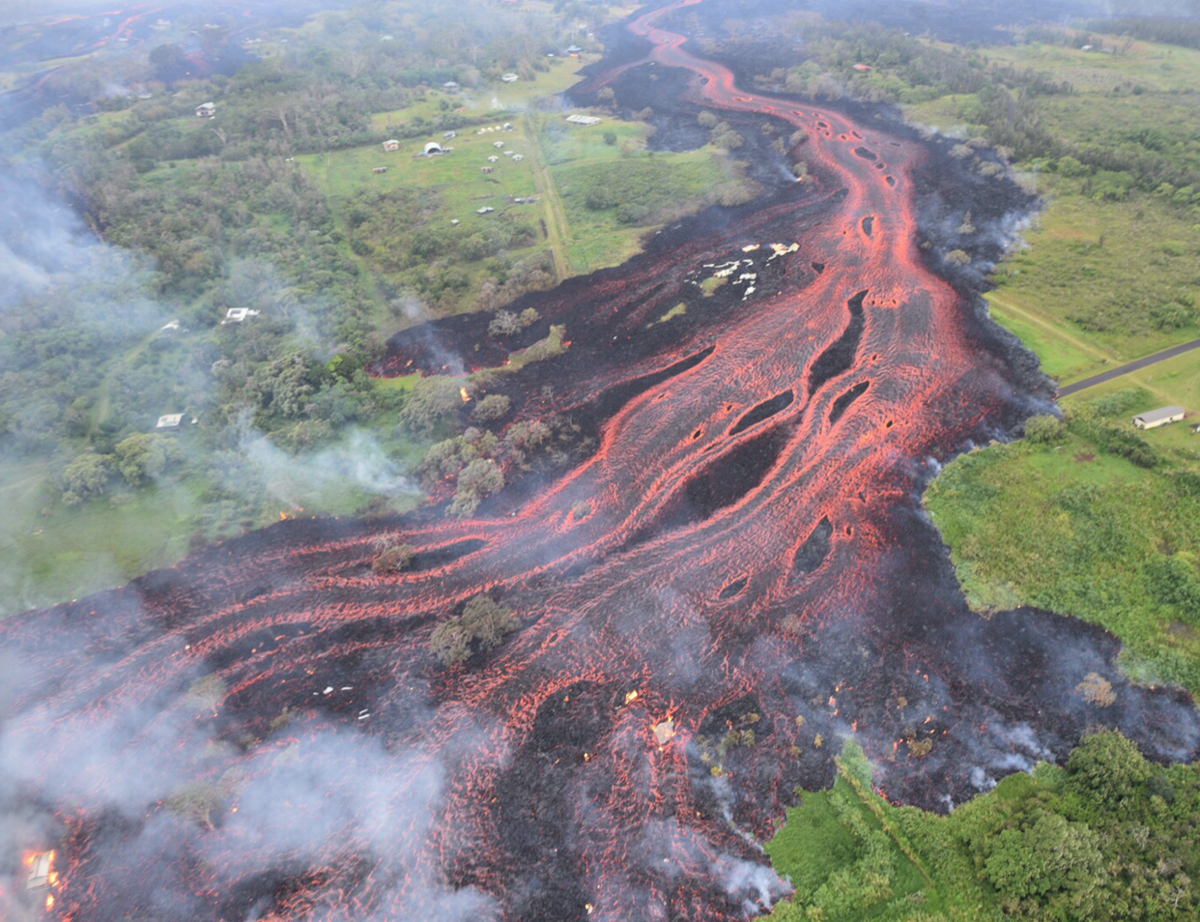
Channelized flows on May 19. Image from USGS.
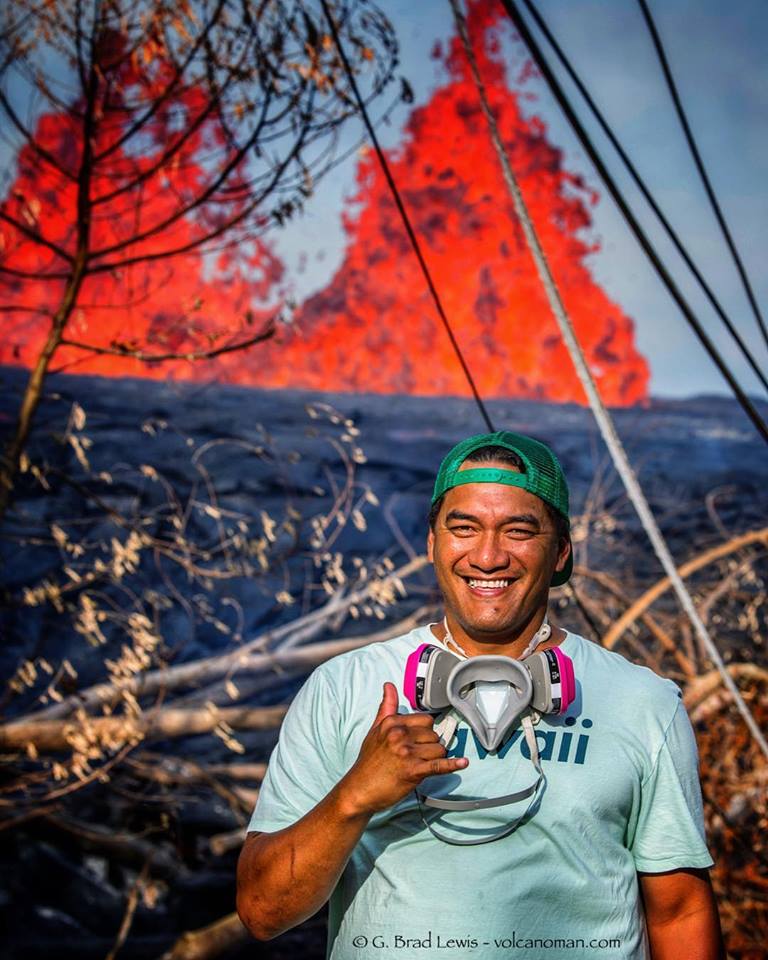
As the lava flows began to ravage the landscape and community, the phrase "Puna Strong" became a rallying call. The Puna community came together in an extraordinary way with volunteers providing food and relief assistance to evacuees at a hub called Pu'uhonua o Puna in the central town of Pahoa a couple of miles from the erupting fissures. A well-known musician and boat captain named Ikaika Marzo became something of a local hero with his daily broadcasts on social media with live reports of the ongoing developments. Although many people have been forced to evacuate and many homes have been lost, it has been remarkable that no one has yet lost their life in this eruption. There have been a couple of serious injuries, the first one early on in the eruption when a man got too close to the fissures trying to protect his home and had his leg shattered by a lava bomb, and the second, more recently when a woman was injured when the lava tour boat she was on got too close and was battered by lava from an explosion at the ocean entry. It is also noteworthy that considerable effort has been made by Puna residents to rescue many animals, pets and livestock, from the advancing lava flows.
By the end of May the lava eruption in Puna began to concentrate at one fissure, fissure #8, and from this fountaining fissure a massive river of lava began to form moving down in a different direction from the previous flows, this time toward a heavily populated area around the Kapoho tidepools. When it finally arrived on the night of June 3, it just completely wiped out hundreds of homes and the cherished tidepools, one of the prime locations in all of Hawaiʻi for exploring abundant coral reefs. The volume of lava that has poured from this fissure has been simply astounding. As the channel forms it builds in height as well as length and width. This is due to the fact that the lava cooling at the sides of the flow forms dikes of hardened black lava that holds the molten red lava in the channel. This allows the flow to build in height, and this monstrous flow, some 40-50 ft in height in some places, just obliterated everything in its path. This was a really sad and sobering event as no one could have imagined such devastation. The lava moved so fast that many residents did not have time to take much of their possessions. There were some people who didn't leave fast enough and had to be rescued by helicopter, leaving fully loaded trucks behind to be consumed by the onslaught of lava.
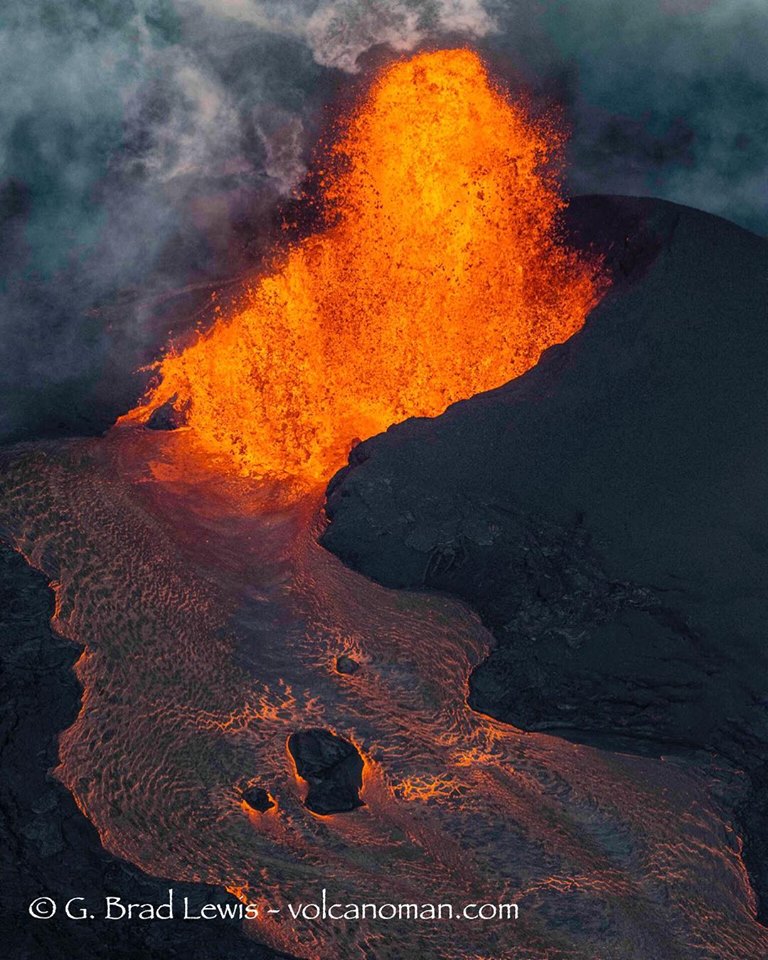
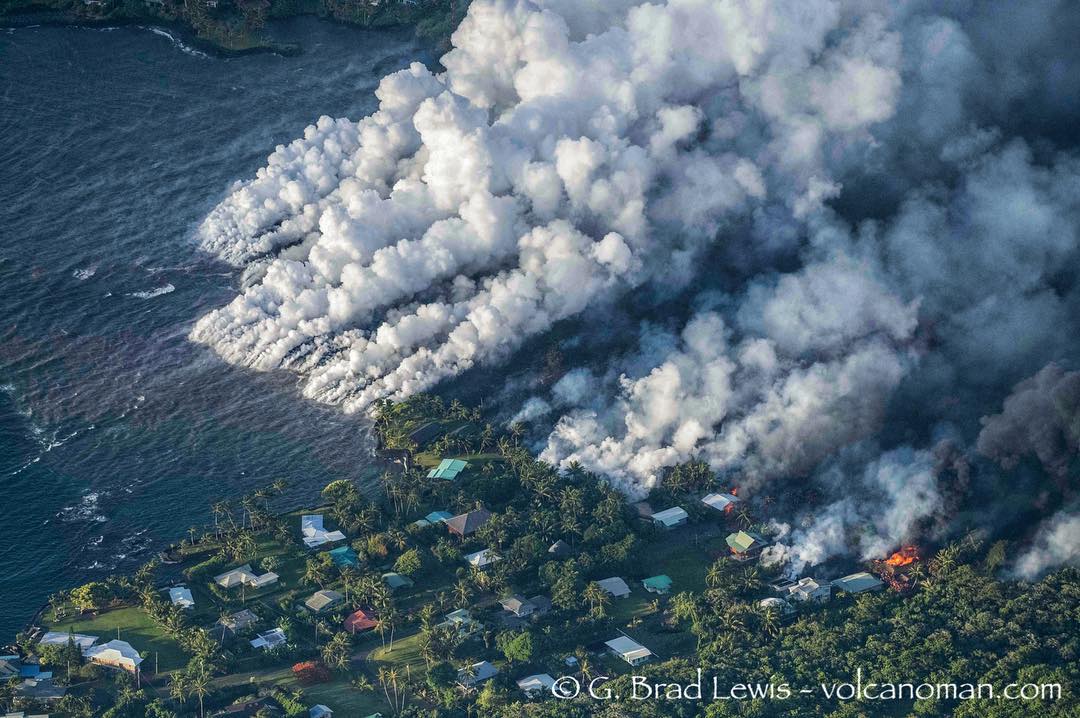
Lava takes Kapoho on June 4. Image from G. Brad Lewis.
The river of lava has poured out of fissure #8 unabated for almost two months now, adding acres new land to the coastline. We've seen absolutely stunning video footage of the fountaining vent and the river of lava moving at astonishing speed. Chunks of rock as big as school buses are carried by the river of lava to the ocean. Back on May 3rd when I stood at the driveway of the house where my friend Keri was staying I wondered if the lava was going to come close to where I was standing. I just could not have imagine that this unbelievable river of lava would pass right next to the house, just in front of where I was standing. This image was taken on June 10, and the house where she was living is the one with the green roof at the top left center of this picture.
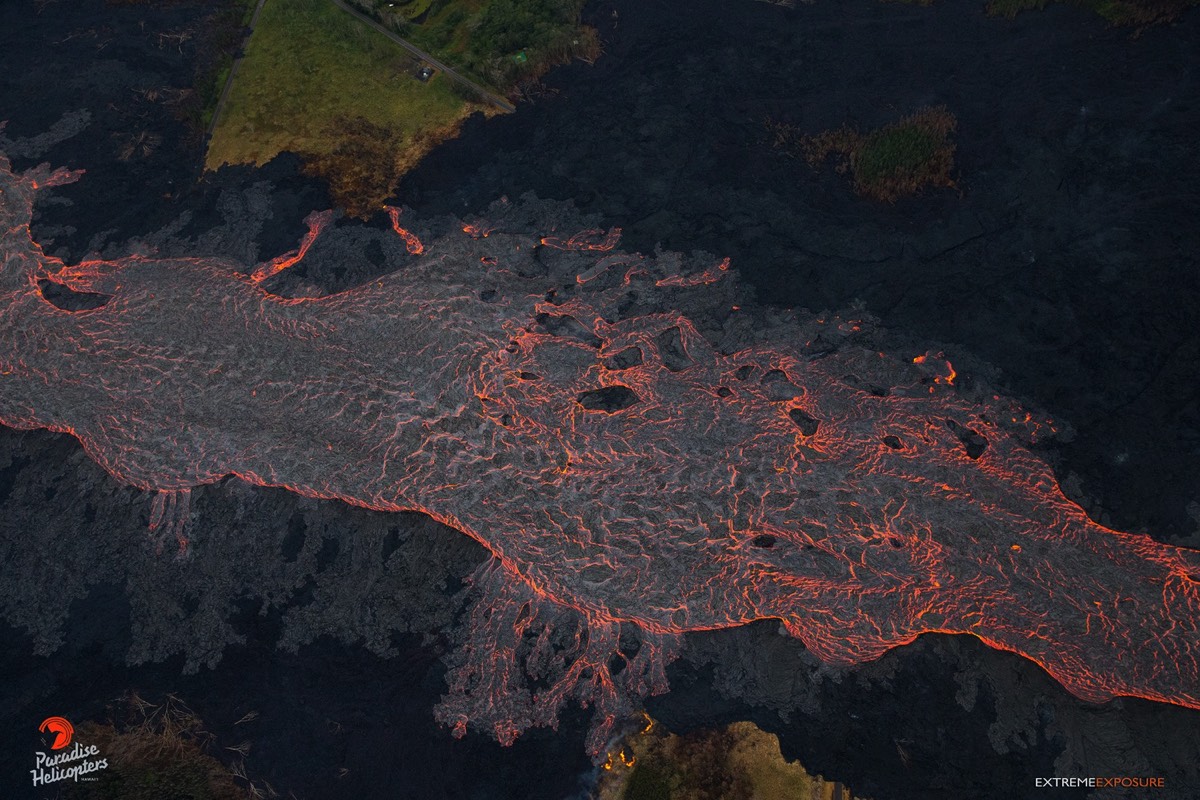
It is hard to really comprehend the magnitude of what has been taking place with this eruption of Kīlauea, in respect to both the volume of lava erupting in Puna, the devastation that this has wrought, and what is taking place at the summit. Over the years I have lived here I have had some close encounters with lava on numerous occasions. There is something inexplicably captivating about seeing lava so close that one can hear it, smell it, and feel the heat pressing against one's skin. I've been in a few tight spots where I probably shouldn't have been and felt moments of fear knowing that one is just a moment away from one's last breath. But I have never seen anything like this before, and never has anyone else in living memory seen a flow like this from Kīlauea. I have not been able to see this flow as access has been strictly limited to area residents and professional reporters and photographers.
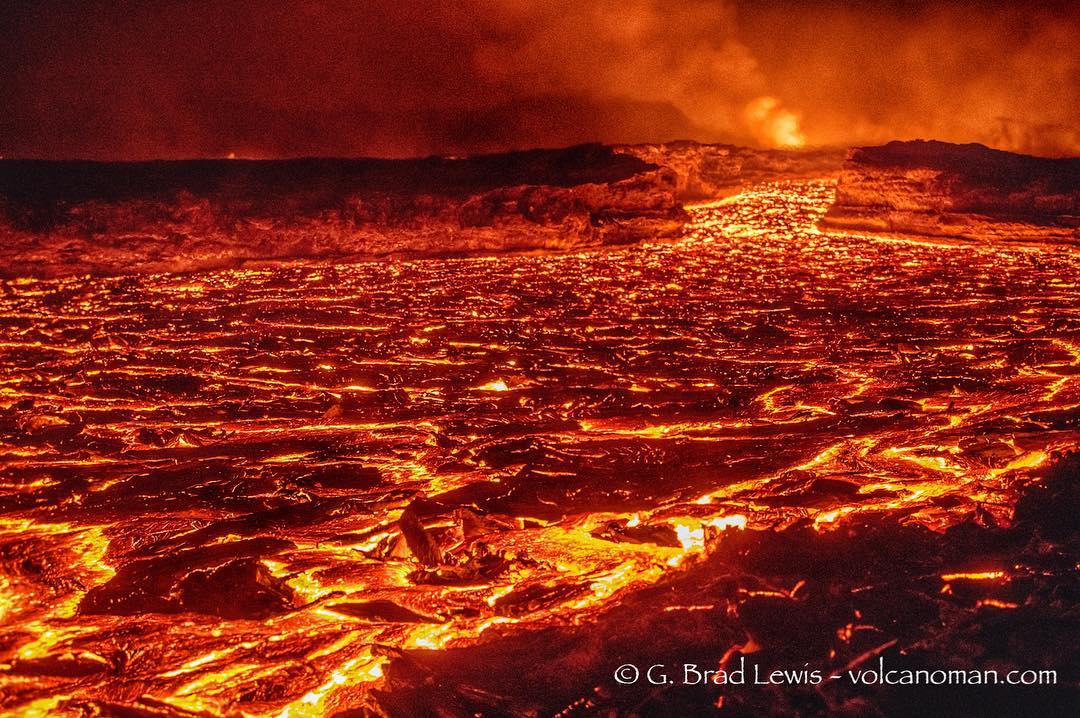
Lava flow from fissure #8 on July 11. Image from G. Brad Lewis.
The flow had been fairly stable for several weeks entering the ocean in the area around where the Kapoho tidepools used to be. The river of lava poured into the ocean along a broad two mile entry point creating large plumes of laze, which is extremely acidic condensate resulting from the mixture of molten lava and cold sea water. In early July a blockage upstream diverted the lava along a new course, which has led to further devastation along the Puna coast. On July 11, the beloved warm pond of Ahalanui Beach Park was inundated. All that is left are fond memories of a place that no longer exists. As I write this on July 24, the lava has been approaching Pohoiki Bay now for several days. It is the only boat harbor on the Puna coast, another place where there are warm ponds to soak in, and also a favorite surfing spot.
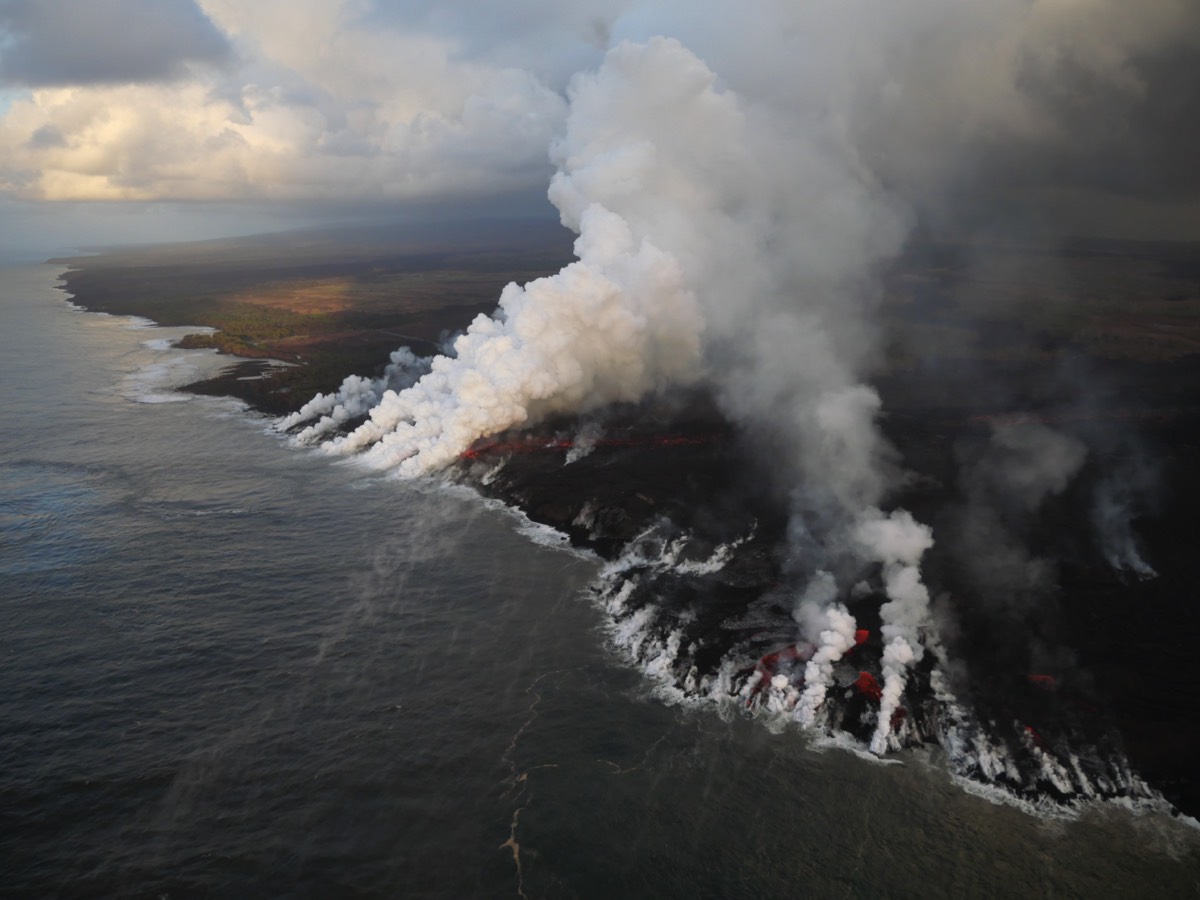
Ocean entry on July 14. Image from USGS.
Although the town of Pahoa is the political and economic center of the community, for many locals Pohoiki is really the heart of Puna. In this image from July 14, the ocean entry at the bottom has covered over Ahalanui while the upper flow approaches Pohoiki Bay. If the lava takes Pohoiki, as it seems inevitable now, most of the treasured Puna coast will have been wiped clean, its verdant green tropical landscape covered over with a layer of desolate black lava, the teeming marine life in its deep cerulean blue waters boiled alive by the scalding heat of the incandescent lava pouring into the ocean. I've seen the lava entering the ocean up close before on a number of occasions, during far less voluminous flows, and it has always been mesmerizing to see such a dramatic confluence of the elements, the orange fiery earth entering the cool blue waters, and the white bellowing steam rising across the sky. At night I've seen glowing lava bergs carried off by the waves into the dark sea. It is to see such spectacles and marvel at the birth of new land that so many people from around the world flock to the Big Island. Yet no one alive has seen here such a flow as this and witnessed such profound devastation; even though we all know, through the chants and stories in Hawaiian lore of Pele's awesome power, that this is always a possibility living on the slopes of a volcano.
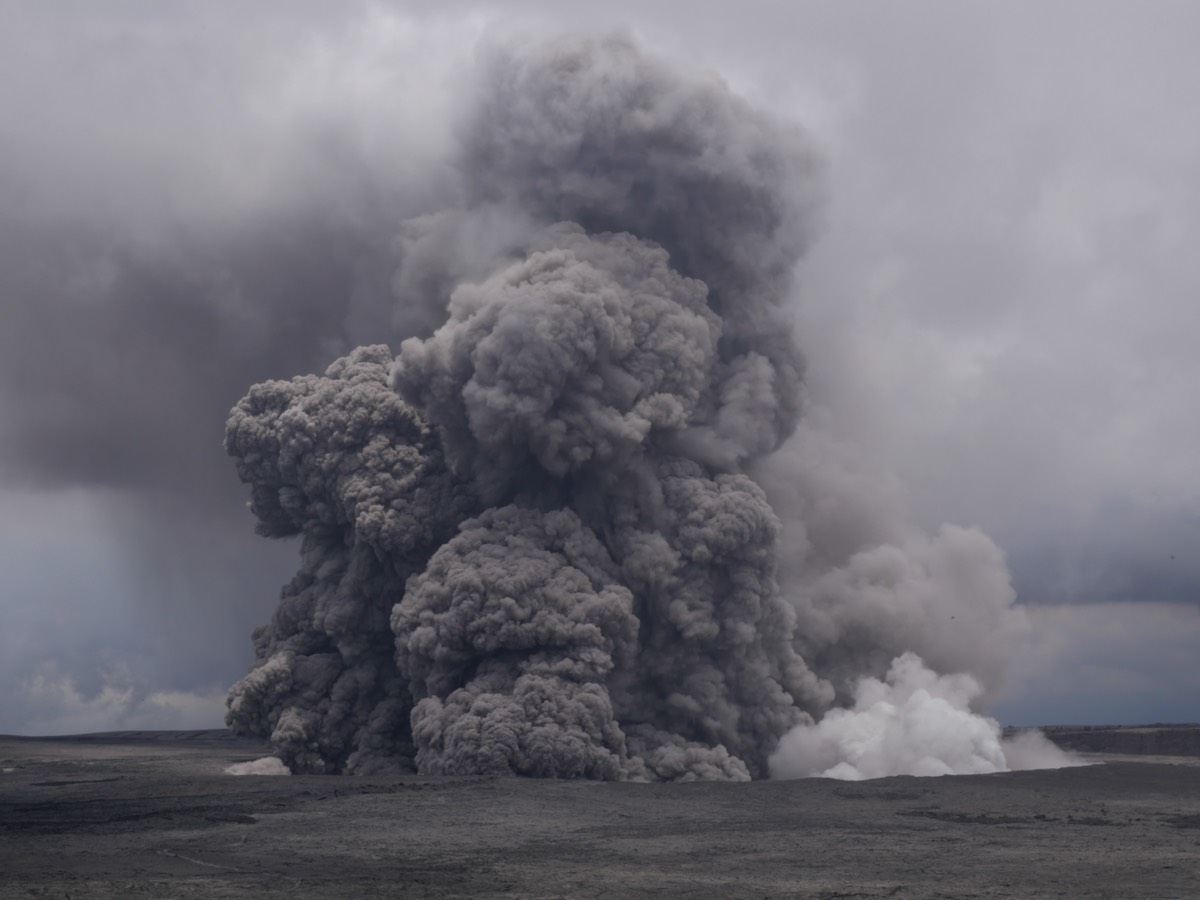
As shocking as the eruptions of lava in Puna have been, the developments at the summit have been just as unbelievable. The geologists had explained at the meeting on May 9th that as the walls of the vent collapsed inward and plugged the vent, more powerful explosions could be expected, perhaps on the scale of the explosions of 1924. At first some of us thought this unlikely as the vent was far bigger than it was in 1924, spanning something like 12 acres. It just seemed inconceivable that the whole vent could get plugged. Then the really astonishing things started happening. The walls of the vent started to collapse more rapidly and the vent itself expanded to something like 120 acres. Then the walls of the wider Halemaʻumaʻu crater began to fall in and this plugged the vent, leading to the explosions the scientists had warned were likely.
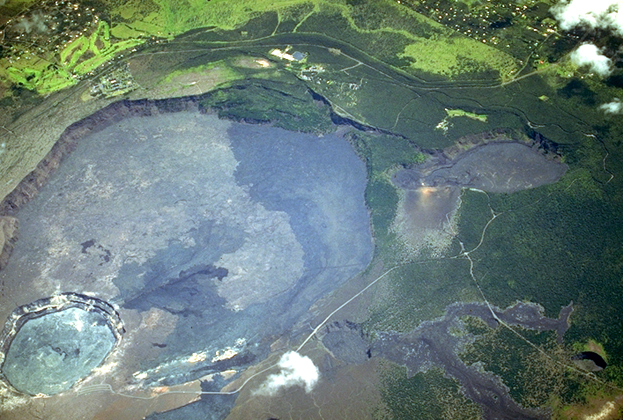
The basic dimensions of the inner crater of Halemaʻumaʻu, as we had come to know it, were shaped by the 1924 eruption. These SOEST stock images show the summit caldera and the Halemaʻumaʻu crater within the caldera before the vent opened up within Halemaʻumaʻu in March of 2008.
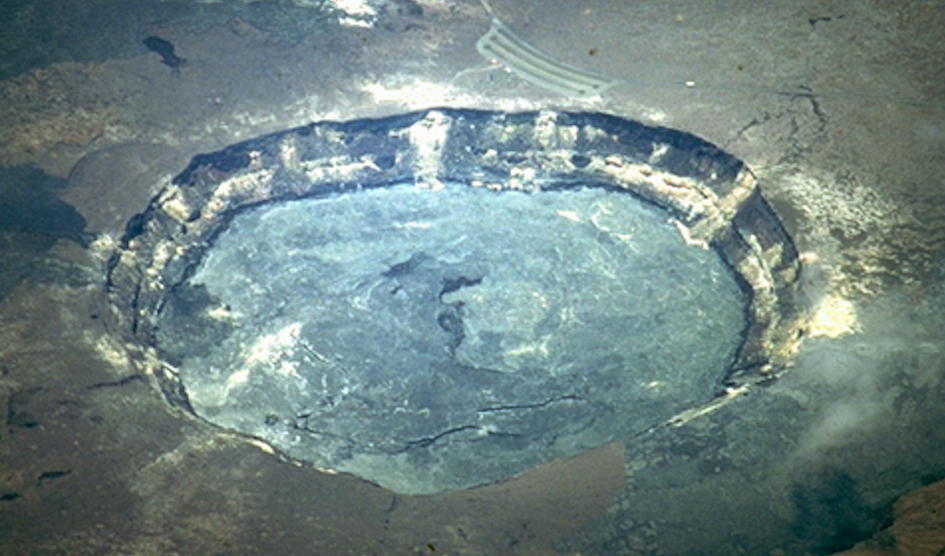
By the end of May huge sections of the wider caldera floor of Kīlauea began to collapse into Halemaʻumaʻu. By the beginning of June this wider collapse changed the dynamics at the summit. These images show the early progression of the collapse of the summit in June. In the image on the left on can see that the Halemaʻumaʻu overlook has already collapsed into the vent, and in the image on the right the parking lot is starting to fall in as well.
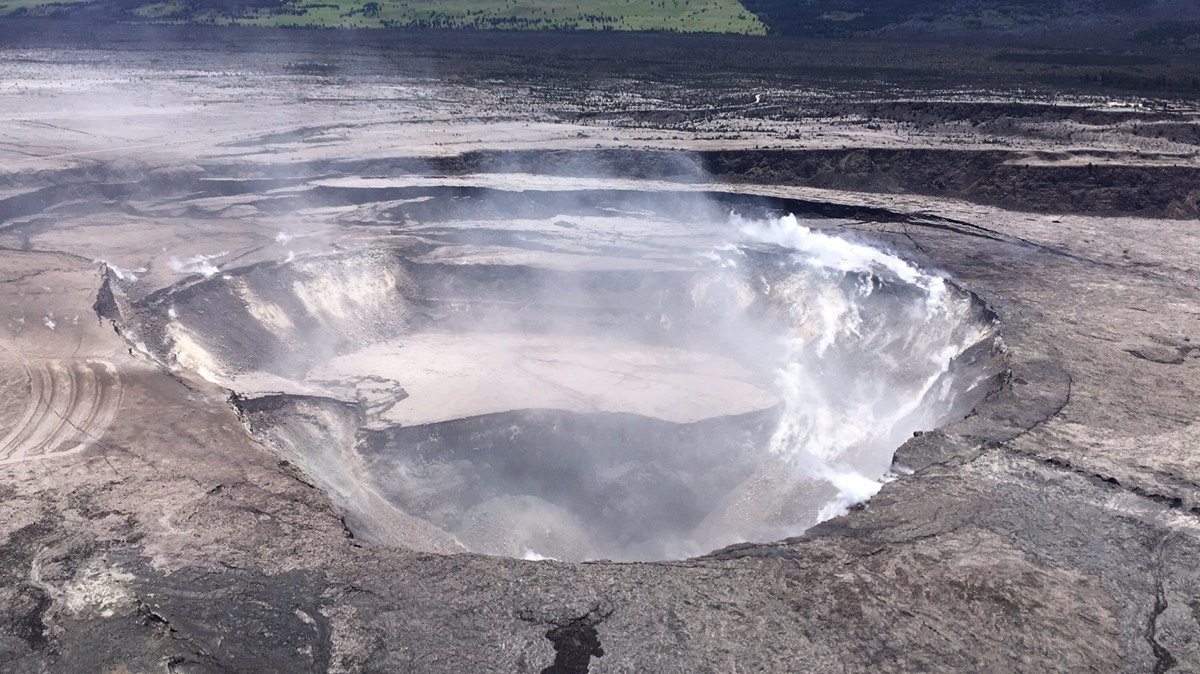
Summit collapse on June 6. Image from USGS.
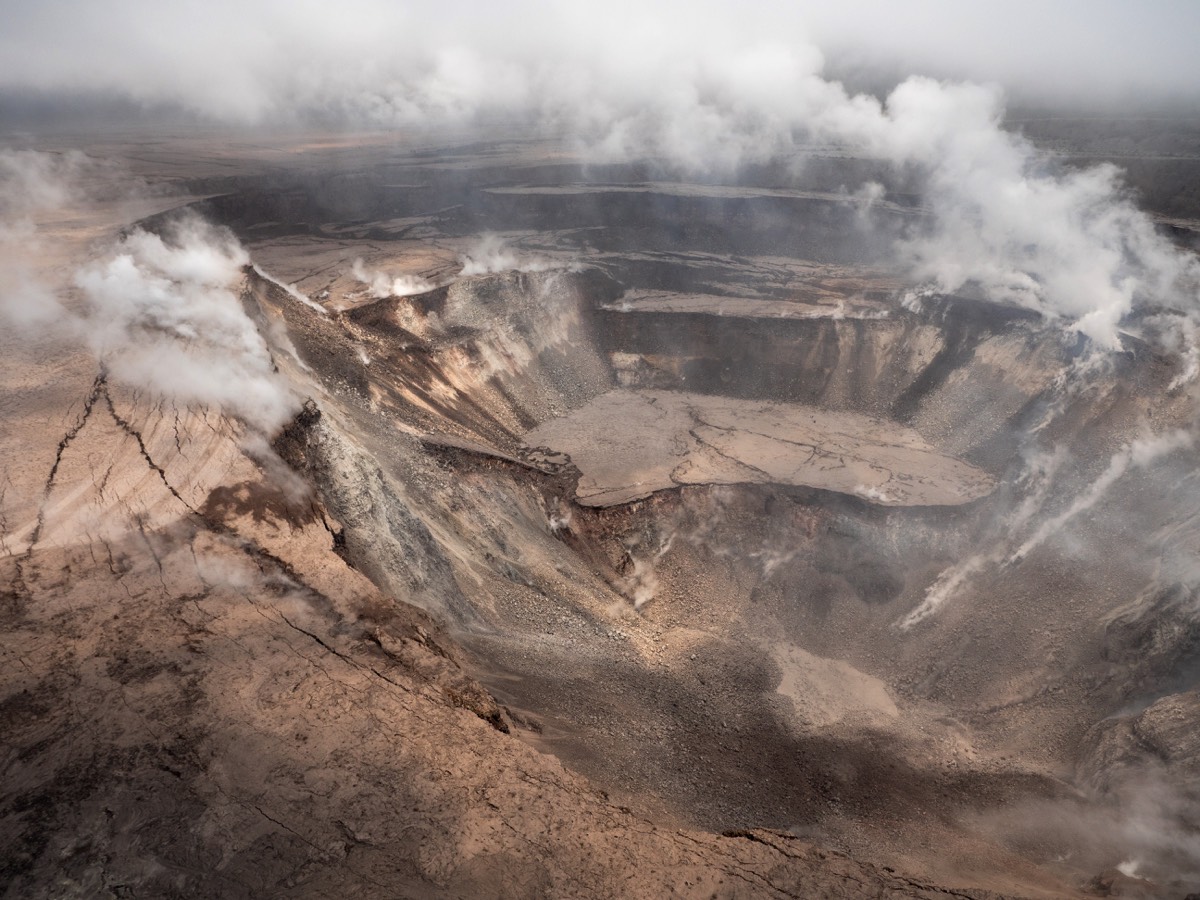
Summit collapse on June 12. Image from USGS.
At another meeting in Volcano on June 7, the question came up again about the possibility of a really big catastrophic explosion at the summit. Tina Neal, the scientist-in-charge at HVO responded, as had lead geologist Don Swanson at the May 9 meeting, that they considered this highly unlikely. Yet in contrast to the response at the earlier meeting, she added in closing remarks that such an event "cannot really be taken off the table" either. I'm sure many of us went home that night thinking about those words.
Swanson explained in yet another meeting at the end of June that the event at the summit could no longer accurately be described as an eruption. It was instead a collapse. As massive amounts of lava drained out in the lower east rift zone, the summit caldera was collapsing into the vacated magma chamber beneath the summit. Instead of the frequent explosive eruptions of May, the subsidence of the caldera caused almost constant earthquakes shaking the summit regions. Everyone living in the summit neighborhoods has felt hundreds of earthquakes in the 3.0 range since the beginning of June, and all of these smaller quakes build up to a bigger event in which the crater floor drops another few meters, with that collapse registering as a 5.3 or 5.4 earthquake. It is not really an earthquake and thus not widely felt beyond the summit region, but for those of us near the summit it is a really good shake and it happens just about every day. For most of June the big jolts happened almost like clockwork in regular 24 hour intervals. In recent weeks the time between the collapse events has lengthened and the big shake has become less predictable. If I am home when it happens I can hear the collapse. It doesn't sound like an explosion, but more of a great rushing sound, almost like a huge wave crashing against the shoreline, or a great wind blowing through the forest.
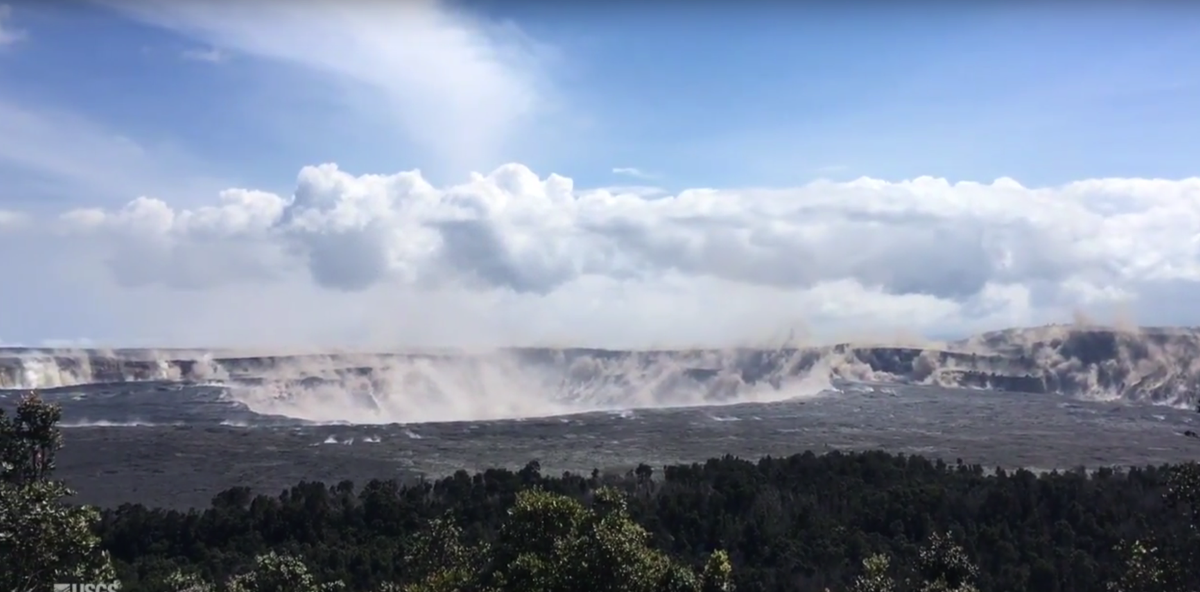
Screenshot image from USGS video of a collapse event on July 12. Listen to the sound of the collapse in the video.
This image from a USGS video shows the collapse of the caldera as of July 13, 2018. Images collected from a helicopter overflight were used to produce a digital elevation model showing the depth of the collapse of the Kīlauea caldera. One can see that the Halemaʻumaʻu overlook parking lot, as well as the whole road on that side of the crater, has fallen into Halemaʻumaʻu. Moreover, one can see that the collapse into Halemaʻumaʻu has extended over a wide area of the floor of Kīlauea caldera. The name Halemaʻumaʻu means something like 'the house (hale) lined with aʻumaʻu ferns', and it designates the abode of Pele. It seems that Pele has undertaken a massive renovation and enlargement of her home. The consequences of this for everyone living in the summit region near her abode remain uncertain and a topic of great concern and speculation among Volcano residents.
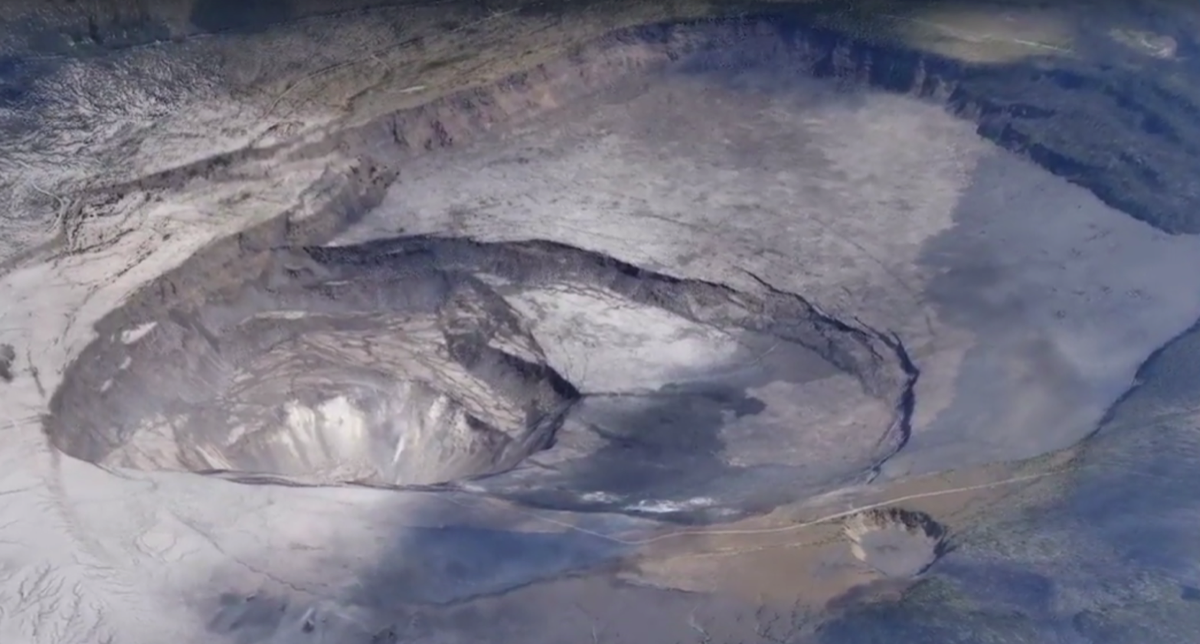
A few years ago I remember being stunned by a small scale model display set up on the observation deck of the Jaggar Museum adjacent to the US Geological Survey's Hawaiian Volcano Observatory. The display illustrated what occurred some 500 years ago when the summit collapsed. Based on the angle of lava flows from the period, geologists understand that the whole Kīlauea summit was several hundred feet higher than it is today. Then there was a collapse in which the entire summit caldera dropped some 2000 feet. Over the years since then, the volcano filled up to where in modern times the floor of the caldera was only about 200 feet below the rim of the caldera. When I first saw this display, I thought that it must have been really interesting to have had lived here then. Thus, at the meeting at the end of June when the HVO scientists and National Park Service personnel explained the ongoing events at the summit, when it came time to ask questions I recalled that display, and asked whether something like that may be happening again. Tina Neal responded first, acknowledging that this has been something the geologists have discussed, but as in the earlier meetings, she reported that they had concluded that such a scenario was unlikely. Swanson added that it is not known how long it took for that huge collapse 500 years ago. It is not likely that it happened all at once, and may have taken months and even years for the caldera to fall 2000 feet. He reiterated that it still seems unlikely that the current collapse is going to be on the same scale as the event 500 years ago. But then he added, "ask again in a month or two."
Swanson also added that he didn't think that such a collapse as occurred 500 years ago would necessarily be a catastrophic event. The collapse then did not extend beyond the boundaries of the caldera, and thus may not be a real danger to the surrounding communities. Neal did caution, however, that we should always be prepared to move should conditions change, reminding us that this is the risk we all take in living on the slopes of a volcano. At the end of the meeting a reporter from the local paper came up to me and said he liked my question and wanted to interview me. He asked what it was like living up here, and I responded that it is quite a challenge getting used to all the earthquakes. One begins to think one is getting used to it, and then there will be a jolt that catches one off guard and gets the adrenaline pumping. And almost every day there is the large quake in the 5 point range that shakes the house quite strongly. In the paper I was quoted as saying: “Every time, you wonder if this one’s going to be the big one, if this one isn’t going to stop.” Perhaps it is an irrational fear as the scientists keep reassuring us that the really big catastrophic explosion is very unlikely, but in the middle of the shaking there is just a moment where one begins to wonder if this might really be it.
Since that meeting the collapse at the summit has widened and deepened. Although the collapse has not extended all the way across the floor of the caldera of Kīlauea, it has already reached a depth of 1400 feet. On July 17, the USGS released a report stating that the current eruption of Kīlauea is unprecedented in scope and size in the past 200 years. At the summit it is the largest collapse in volume in the past 200 years, and the lava eruption in the lower east rift zone is also the most voluminous with the highest eruption rate in the last 200 years. Just to give some perspective on the scale of the eruption, the report stated that the eruption in 1840 lasted 26 days and released 205 million cubic meters of lava, the 1955 eruption lasted 88 days with 81 mcm of lava, the 1960 eruption lasted 37 days emitting 122 mcm of lava, and the current eruption has lasted (as of the day of the report) 80 days and a whopping 450 mcm of lava has already poured out of the rift zone. I think it is fair to say, as I gathered in talking to several of the geologists after that meeting, that the scale of the eruption has shocked even the scientists. It is clearly a career-defining event for the scientists at work on this eruption. I think it is perhaps also fair to say, that as no one had expected an eruption of this magnitude, that the scientists don't really know what is going to happen next. We have only the best educated guesses to rely upon. Here we reach the limits of science, especially geological science, where there is simply a limited set of data points upon which to base any reliable prognosis.
So one might reasonably wonder why one would want to live on the slopes of a volcano, especially so dangerously close to the summit caldera? Why would one want to take the advice of the mad philosopher anyway? And just what did Nietzsche mean when he suggested that the secret to harvesting the greatest fruitfulness and enjoyment in life is to live on the slopes of a volcano? Before getting to this last question, I must first explain a bit of my own story and why I chose to live up here near the summit of Kīlauea. While it has something to do with Nietzsche, it was not because I was taking literally the advice from this famous, though not well understood, quotation. It was rather because I decided to come to the Big Island, at the time I was beginning to write a dissertation on Nietzsche's philosophy, in order to watch a total eclipse of the sun on July 11, 1991.
The Abode of Pele
I first came to the Big Island in the summer of 1988, with two of my brothers who had come to visit while I was working on a Ph.D. in philosophy at the University of Hawaiʻi at Manoa. We took the trip to the summit and looked down onto the floor of Halemaʻumaʻu from the overlook that now no longer exists, and we saw lava streaming into the ocean from the flows from Puʻu Oʻo that would later that Fall begin to overrun the town of Kalapana. Three years later I would return for one of the most significant experiences of my life. I came with a friend from Honolulu and his two friends from Los Angeles. I had known about the solar eclipse for some time, but didn't get plane tickets in time to fly to Kona, which promised the most optimal viewing conditions for seeing the eclipse. So we flew into Hilo with our bikes a couple days in advance. We had to decide where we were going to try to see the eclipse. It would be an arduous journey either over the old Saddle Road or around the Hamakua coast to the Kona side, and the two Californians had not been to the Big Island and wanted to see the summit of Kīlauea. But the Volcano area was not the optimal place to see the eclipse as there was a 60% chance that the eclipse would be obscured by cloud cover.
So I suggested that we bike up to Volcano on day one and then ride down on day two to the Kau desert area to the southwest of the summit, which was considered the 2nd best place to watch the eclipse. It was a challenging ride to make the 30 mile and 4000' climb to the summit. It was probably the most exhausted I have ever felt when we reached the summit and pitched our tents at the Namakanipaio campground. The next morning we decided to ride to the southwest rift zone of the crater to watch the sunrise over Halemaʻumaʻu. It turned out to be the most perfect sunrise. A day before the eclipse and there was not a cloud in the sky. So we decided to stay right there and not ride down to Kau.
By the afternoon it had started to look like a bad decision as clouds moved in and it began to rain. It rained all night and in the morning when we road to the Jaggar overlook it did not look good. They had a radio on in the museum and the weather report was dismal. A front had moved in and the whole island was going to be covered with clouds. About the only place to see the eclipse would be the summit of Mauna Kea above the clouds. Everyone was pretty bummed out, especially the Park ranger who had been so excited the previous day. Well shoot, I thought, we rode our bikes all the way up here and it is still going to be a great experience. I was standing inside the museum when I saw a shaft of sunlight break free over the crater. 'Look at that!' I shouted and we ran outside to our bikes. There was a hole in the clouds breaking over the summit.
We raced as fast as we could down to the southwest rift zone and when we arrived we had a clear view of the moon beginning to pass down over on top of the sun. We saw the whole thing just the four of us on the edge of the caldera looking across Halemaʻumaʻu. Just before totality I could see the mountains of the moon against the sliver of sun through my binoculars and the eclipse viewer. When totality began I could see the corona of the sun and a prominent solar flare bursting out from the top of the sun. As stunning as it was to watch the celestial event through the binoculars, it was only when I peeked and looked at the eclipse over the crater that I saw what really took my breath away. Awestruck, I let the binoculars fall and gazed at an incredible sight.
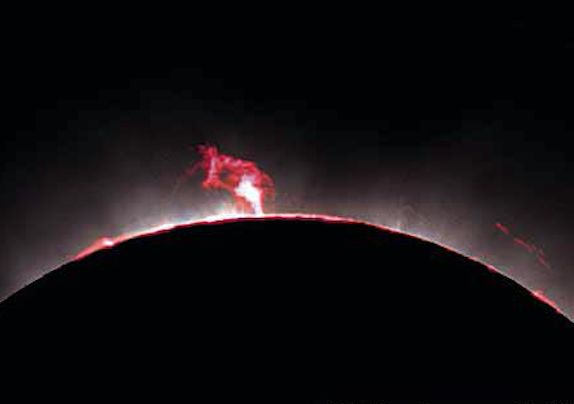
Unfortunately, I did not have a camera good enough to capture what I saw then. When totality occurred, it not only got noticeably darker and colder, the steam vents within Halemaʻumaʻu that had been billowing in the wind when we first arrived, now rose vertically straight up as columns. I realize that it was the result of how still it got, a dramatic demonstration perhaps, of how much the sun drives the wind; but it seemed as if Pele herself had paid homage from her summit abode, sending a signal to the heavenly gods. It was a sight I'll never forget, seared in memory till the end of my days.
Toward the end of totality the clouds moved in and obscured the eclipse. We didn't see the sun again for the rest of the day, but we were ecstatic to have witnessed such an event. We rode down the mountain that afternoon screaming with joy in the blistering rain. It was this event that led me ten years later to take a one semester visiting assistant professor position in Hilo instead of a more permanent position in California, and this experience that led me to want to live in Volcano village near the summit of Kīlauea. I felt as if I had been drawn irresistibly, ineluctably, by forces much larger than mere career considerations, to live near Pele's abode. I have never regretted the decision, not even now as the summit area is shaken by the constant convulsions of the summit collapse. As I said earlier, it has been my absolute favorite place I have ever lived.
Each of the Hawaiian Islands has its own unique feel or 'energy' if you will. The Big Island radiates a powerful presence. Measured from the seafloor, Mauna Kea is the tallest mountain on earth, while Mauna Loa, only slightly smaller in height, is by volume by far the largest mountain on earth. Kīlauea is the world's most active volcano and its summit region has been a magical place to live. As I said, I love to feel and breath the high-altitude rarefied air. I long to return to its coolness when I am down in the hot and sticky lower elevations. I have loved hiking through the volcano landscape, taking in spectacular summit vistas along the way.

Summit landscape in January 2015. Photo by Tim Freeman.
The summit of Kīlauea offers the most startling contrasts. On the western side of the caldera one finds a dry, desolate fractured volcano landscape, while on the eastern side one can hike through the most beautiful, almost pristine, native Hawaiian forest.
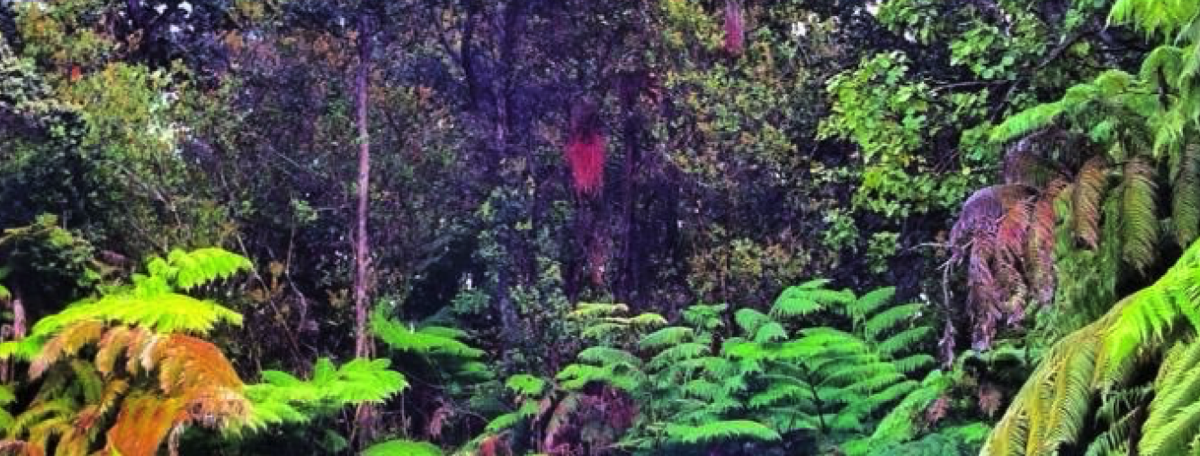
The forest where I lived in 2007. Photo by Tim Freeman.
Perhaps the most enchanting thing of all about living in the summit region is the sound of the forest, from the songs of native Hawaiian birds. I especially love the beautiful scarlet apapane. It turns out the apapane love to bathe in water and so I made this little birdbath. When I hear the symphony from the trees and look out my window and see the apapane so joyfully enjoying the water, I know I am in a very magical place. I modeled the sculpture after the famous fresco of the Bodhisattva with Lotus from the Ajanta Caves in India. The Bodhisattva is a Mahayana Buddhist ideal, the enlightenment hero who vows to come back again and again to this world in order to help all beings attain enlightenment. I like the Bodhisattva ideal as it stands in such sharp contrast to the world-denying philosophies built upon a longing to escape this world because it is so often experienced with such anguish and pain. I put the Bodhisattva there as a constant reminder of the Mahayana teaching that enlightenment is possible in this present moment and the Bodhisattva vow that encourages one to do what one can to make this world a better place rather than longing to escape it.
Sometimes it just seems so unbelievable that there could be a place of such gentle, tranquil beauty so close to a place so desolate and inhospitable as Pele's abode. I once took the dangerous and forbidden journey to the Halemaʻumaʻu overlook in order to look down into the pulsing lake of lava. There was only the glow from the lava to light the way in the darkness of the new moon night. The scent of sulphur was strong in the air but the Kona winds blew the plume safely away as I took the last steps to the crater's edge. It was breathtaking, to say the least, when the mass of lava first came into view. The deep red surface of the lava was shattered by cracks of incandescent light that slowly danced across the surface as the result of the upwelling of lava. But it was a calm night by Pele's standards, as the influx of lava was barely perceptible; no violent sloshing or fountaining disturbed the peaceful slumber of the lake. Between the cracks one could see countless points of incandescence sparkling like stars in the night sky. As I watched spellbound, I realized that I was looking down into the open interior of the earth, down into the top of a magma plume that descended perhaps all the way down to the outer core. I realized also that it was this pulsing bloodlike lava that is one of the reasons why the earth is a living place at all. It is the movement of the magma around the iron core that generates the magnetic field that protects the earth from solar radiation. It is one of the things that enables the earth to have an atmosphere, the fragile thin blue line upon which all life on earth depends. I realized that this is perhaps what the Hawaiians revere as Pele, the goddess of the volcano. From what I understand she is not some anthropomorphic deity merely residing in volcanic regions, using the lava as an instrument of her power. Perhaps she is better understood as this force of the molten interior of the earth, the power that both makes life possible on earth, bringing forth the earth through volcanic eruptions, and yet capable, from the perspective of the mere mortals living on the slopes of a volcano, of such terrifying destruction.
Volcano Vessels
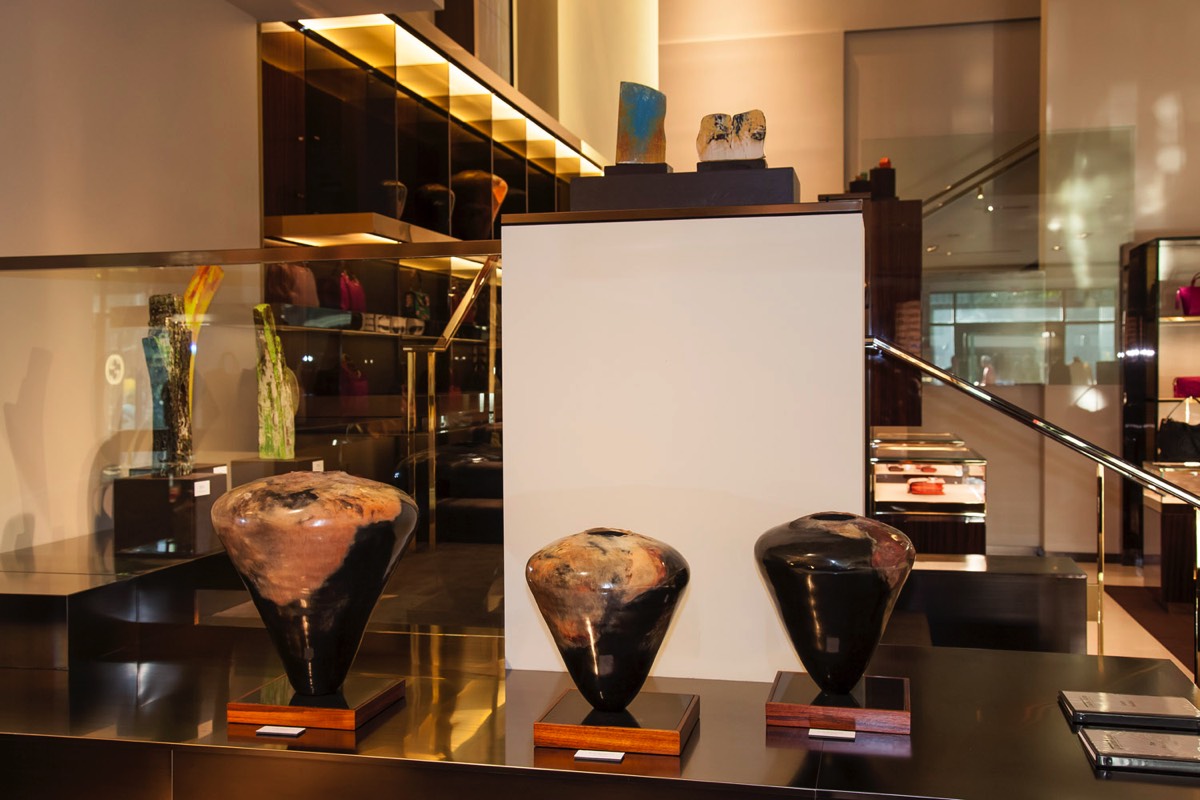
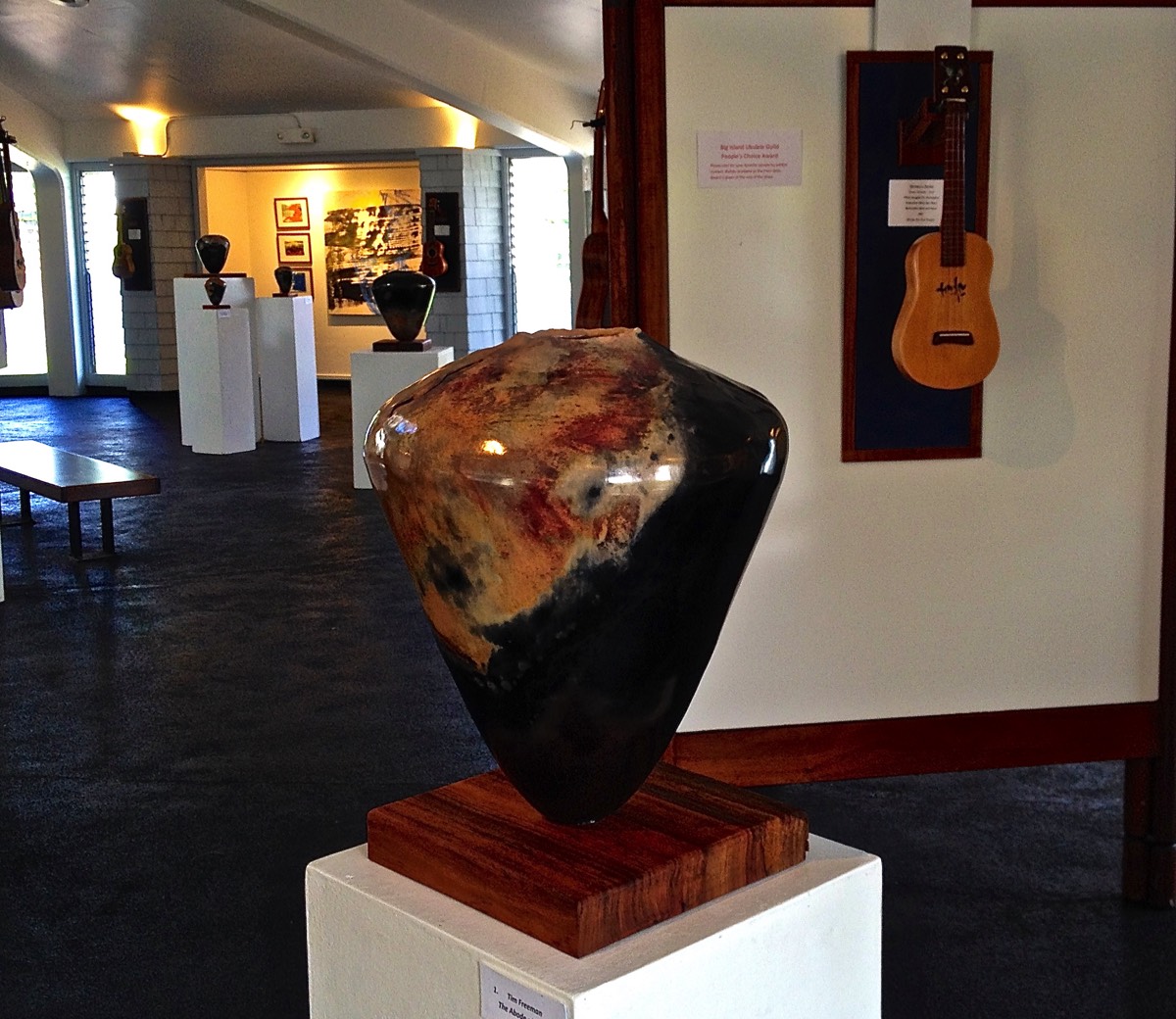
The experience of living in this most extraordinary place in the summit area near Pele's abode has inspired my ceramic art in the last decade. When I was younger I made a lot of functional pottery and some figurative sculpture; and after a long interval in which I didn't do any ceramics, working instead on completing a dissertation and beginning a career in teaching, I had the opportunity in the summer of 2006 to take a workshop on pit firing ceramics. In the workshop we were practicing throwing closed forms on the wheel, and then burnishing them with a polished stone until they came to a polished stone finish. After they are bisque fired, they are placed in a bed of sawdust at the base of a pit, and then carefully buried under a pile of wood that is then set afire. The pit fire is what brings out the color of the finished piece, through the interaction of the clay with the sawdust, the wood, and the fire.
It is one of the oldest methods of firing ceramics. I've seen 5000 year old Egyptian cups in the Louvre that were fired in this way. As it had been awhile since I had done any throwing when I took that workshop, my pieces were fairly primitive. There was one piece that I just didn't like. The form was just not interesting; and thus while I was beginning to burnish it, I decided to turn it over, and open it from what had been the base. The result I found very interesting. It was another three years before I had a chance to finally get back to work in ceramics and explore this discovery. While I was playing with this process of throwing closed forms, turning them over and opening them up again, I suddenly discovered what they were.
I liked the way the clay split and tore at the top as I opened them up. I was careful not to touch this surface, allowing it to be untouched and natural. I realized that it reminded me of the fractured volcano landscape that I so loved hiking through. I guess I had been intrigued by the notion of a sacred vessel since childhood. When one of my uncles was ordained as a priest he received an exceptional chalice. It was something that really caught my eye. When I started making these vessels I was not consciously thinking of that chalice, but I think the very idea of it remained hidden in the back of my mind. The vessels are not meant to hold anything, they are sculptures, works of art that hopefully express something of the tremendous gratitude I feel for gift I have been given in having the opportunity to live part of my life in one of the most special places on earth.
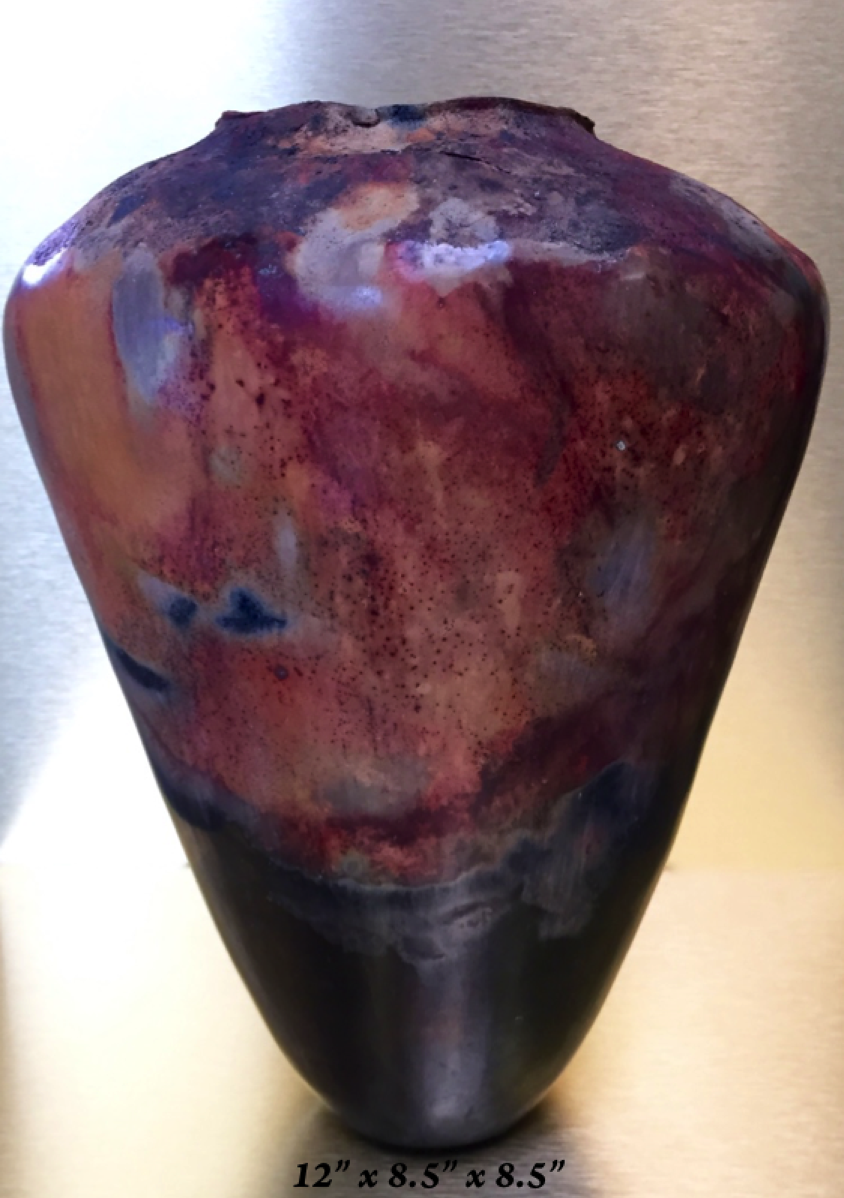
Volcano Vessel, 2016
Now as a result of this eruption I realize this time may be coming to a close. They have issued no evacuation orders or even recommendations for those living at the summit. The geologists have said that it is very unlikely that there will be a catastrophic explosion at the summit, and unlikely that the collapse at the summit, as stunning as it is, poses any real existential threat to those living in the Volcano community. Still, I'm sure the residents of Puna who have lost their homes or have been forced to evacuate did not imagine at the end of April what was about to happen would really take place. I am guessing that the scientists did not think it likely either, when they warned us at the end of April that something was about to happen, that the eruption would turn out to be so large that it would be unprecedented in scope and size in the past 200 years. Yes, they knew that tremendous collapse events have occurred at the Kīlauea summit over time, but they probably did not think at the end of April that such a collapse was likely at this time. Yes, they knew that lava has covered the entire Puna region in the not too distant past, but they probably did not think at the end of April that it would soon devastate so much of Puna.
I think it is probably fair to say that everyone on the Big Island has been impacted by this eruption in some way, if not by the lava flows, or the earthquakes, or the vog, then at least by the economic impact. There is a palpable tension in the air. Everyone would like to know when this eruption will end and just what will happen next. The geologists have been saying lately that it may last for several years. No one really knows of course. As I write this on the morning of July 26, there has been no collapse event resulting in a 5 point quake at the summit in the last 48 hours or so, the longest interval between big shakes since this phase began at the end of May. Everyone is waiting for the next big jolt.
Celestial Events and Earth Changes
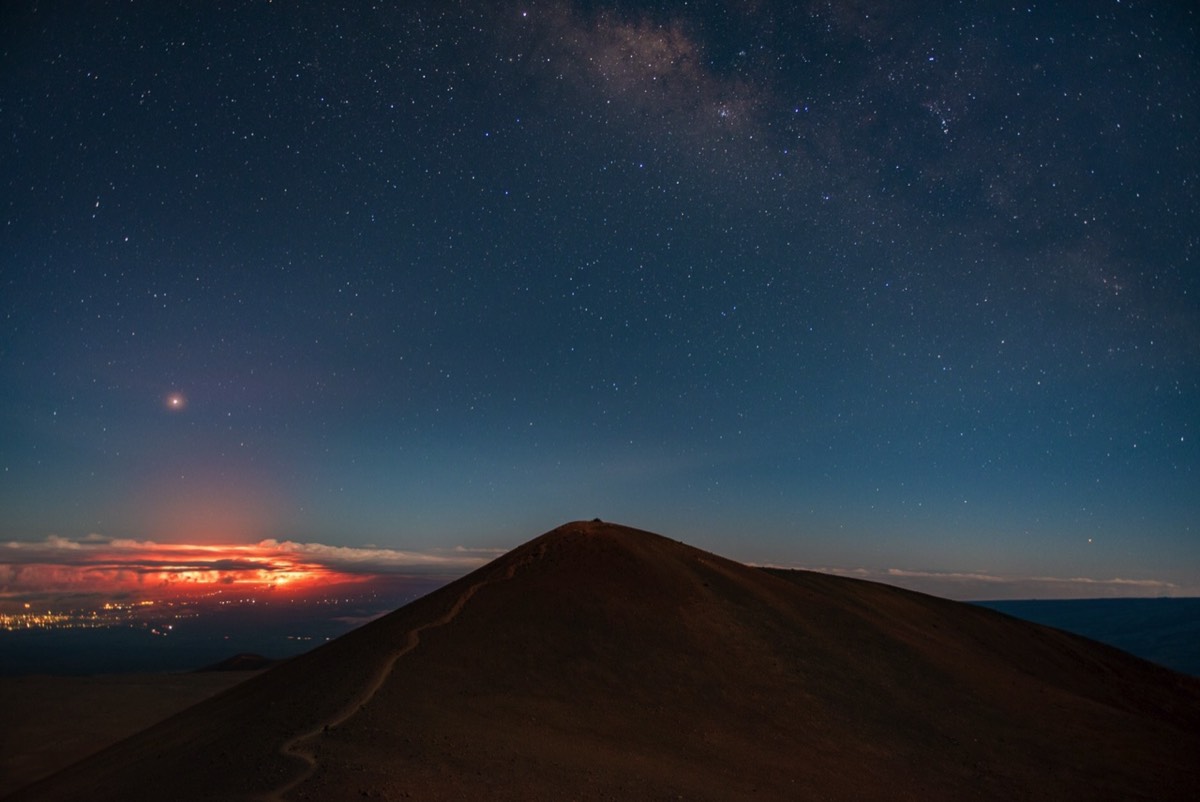
Mars Rising Over the Eruption. Photo taken on June 21 from the summit of Mauna Kea, Hans T. Klett.
There are those who look to celestial events for clues as to what may happen in the days ahead. Apparently there is a rare astronomical formation happening now and for the next several weeks in which all the planets are on the same side of the sun. Although astronomers point out that the combined gravitational influence of the planets is negligible compared to that of the Sun, the planetary formation has occurred only 6 times in the last 120 years and supposedly has happened at times of elevated volcanic and seismic activity around the world. Then there is also tomorrow a 'blood moon' lunar eclipse that astrologers regard as the most potent of our lifetime, one that has great potential for explosive eruptions in interpersonal, geopolitical, as well as geophysical affairs.
I know that there are many who would be surprised that a highly educated academic philosopher would even consider taking such things seriously, but I have to confess that I do. I have the utmost respect for science and think that one should take the conclusions of scientific inquiry seriously even when they challenge dearly held beliefs. But I regard the scientific dismissal of astrology as a blind spot. It is, of course, one of the basic assumptions of science that one should examine the evidence for a theory, but most scientists simply dismiss astrology without even considering the evidence. This is simply the result of some fundamental misunderstandings about astrology, as well as historical and philosophical developments that took place during the development of modern science. Of course, some of the early astronomers before Newton, figures such as Tycho Brahe, Johannes Kepler, and Galileo Galilei were practicing astrologers. The dismissal of astrology is a consequence, I think, of two developments, first of all, the philosophical development of Cartesian dualism which radically separates humans from nature, and then secondly, the development of Newtonian mechanics to explain natural events. It thus seems preposterous to even consider that the planets could have any influence upon human affairs, and not even on terrestrial phenomenon like volcanic eruptions since the gravitational influence is so negligible. For me, astrology is not a dearly held belief. It has always been, for 30 years now, an interesting hypothesis requiring evidence, and over that time I have seen enough evidence that I find it preposterous to dismiss it without even looking for evidence. It is a dogma of modern science that deserves to be called into question.
The evidence I have observed has led me to question how it could be so, and that has led me to the hypothesis that astrology is not really based at all on some supposed causal influence of the planets. The negligible gravitational influence is irrelevant. The best explanation I think is the fractal patterning found in nature. Fractal patterning is the simultaneity in structure across scale.
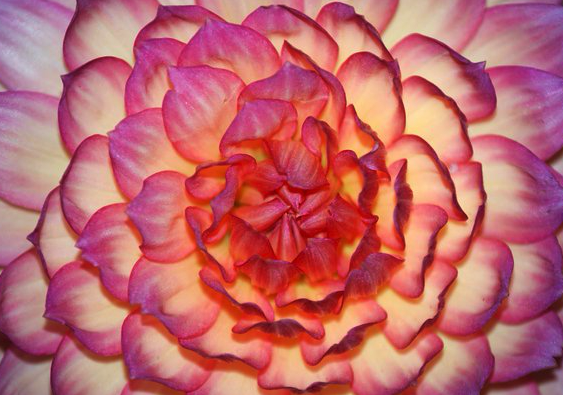
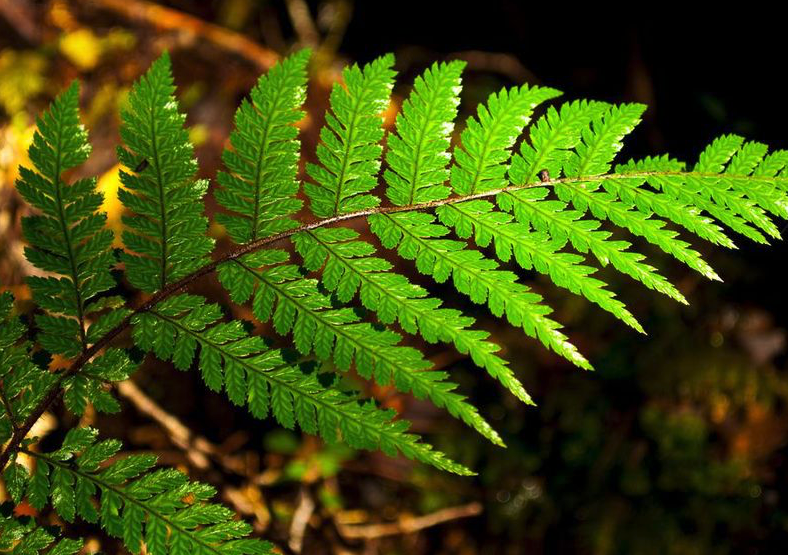
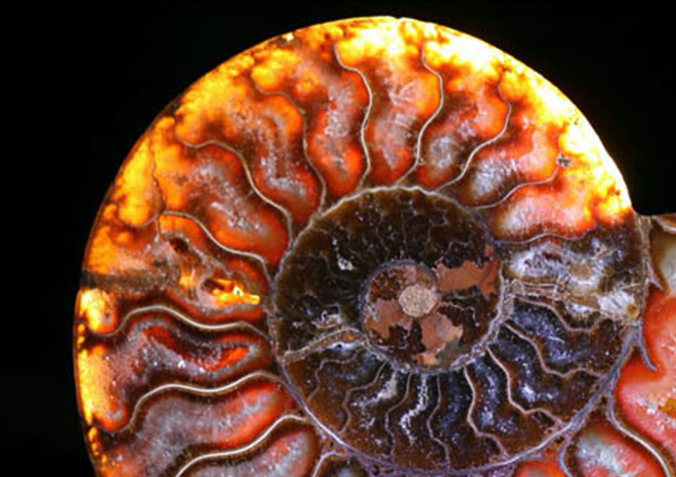
Since mathematician Benoit Mandelbrot first drew attention to fractal patterning in 1975, fractal patterns have been noticed throughout the natural world. One can even see the fractal patterning in a lava flow.
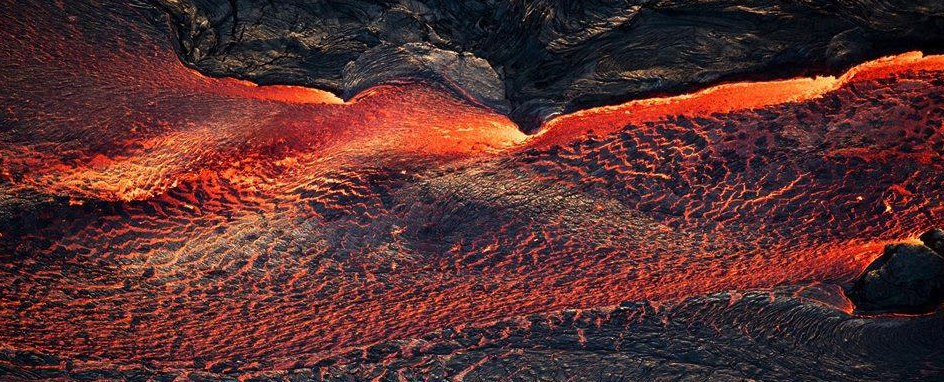
If nature is knit together in fractal patterns, and if Cartesian dualism is wrong and human beings are part of nature, then perhaps it isn't so preposterous at all that celestial events correlate with (and not cause) what happens here on earth, both in terms of natural phenomena and human events. It is not that the planets are causing terrestrial events, it is rather that the whole solar system, and everything within it, is also a fractal pattern. It is infinitely complex and dynamically in motion, but if we all are living within this patterning then it should not be surprising that someone might notice a correlation between celestial events and what happens here on earth, and this is what astrologers observing the night skies have done for millennia.
Another misconception about astrology to be cleared up is to understand that it is not really about the stars. Some scientific minded individuals like to dismiss astrology by pointing out that, due to the phenomenon of the precession of the equinoxes, someone born on this date, July 26, is not really a Leo at all, as the Sun isn't really in that constellation at this time. At least in the Tropical system of astrology, the signs do not really refer to the constellations at all. Tropical astrology is based on the seasons. There are four seasons and three phases to each season and thus twelve signs in the tropical zodiac. The name of the constellation is just a designation for the phase of the season. 'Aries' became the name of the first sign in the zodiac as the constellation Aries was on the eastern horizon at the first dawn of Spring a couple thousand years ago when this system of signs was first developed. It doesn't matter that the constellation Aries is no longer on the eastern horizon on the first day of Spring. If someone is an Aries, then their personality exhibits some traits associated with the beginning of Spring—perhaps a certain brashness or impulsiveness, a move-first-think-about-it-later tendency that one might associate with the sprouts bursting forth from seeds after their winter dormancy.
If one only really took the time to study one's birth chart and understand what it means, and then observe the important transits of planets to the natal chart, I think it would be hard to so easily dismiss astrology. That is how one sees the evidence. One only has to look. I've seen so much evidence, in studying my own chart over the years, and those of friends, family members, famous and historical people (someday I'll have to do a separate blog on Nietzsche's chart as it is one of the most stunning examples), as well as significant events, that I can only roll my eyes and shrug when people scoff at astrological observations. It would take way too much data to present a convincing case here, but I assure you there is a mountain of evidence.
I will here just mention a few things relevant to this current eruption of Kīlauea. Astrologers had been cautioning all Spring that we were coming up on a time in which more earthquakes and volcanic eruptions were likely. This was, in part, because Uranus was about to enter the (tropical) sign of Taurus. The cycle of Uranus around the Sun takes 84 years and thus it changes signs every seven years. Supposedly, when the outer planets change signs, this can signal major events that affect many people. Among other things, Uranus has become associated with sudden, unpredictable events, natural disasters, breaking of structures and revolutionary developments. In contrast to the transits of some of the other planets, it also has been noticed to be fairly precise, and nothing illustrated this more dramatically than when it transited from Pisces to Aries seven years ago. I remember being stunned by the exactness of it at the time. Pisces rules oceans and the last day it was in Pisces was March 11, 2011. That, of course, was the day of the great Tōhoku earthquake off the coast of Japan. The very next day Uranus moved in to Aries. Aries is a fire sign. At the moment when the first big explosion at the Fukushima nuclear plant took place Uranus was at 0°00' of Aries. Ok, it is just one example, one data point, but a pretty stunning one.
Taurus is an earth sign, and thus astrologers were saying that earthquakes and volcanic eruptions were likely. In addition to this, just as Uranus was about to move into Taurus it was in a 90° or square aspect to Mars. Mars square Uranus is a classic combination for sudden explosive eruptions. I was thinking about this all Spring. I wondered where in the world we might see some major event that would correlate with this combination of Mars squaring Uranus just as Uranus was moving into Taurus. Living on a volcano, I was aware that something could possibly happen here. But, of course, I realized it could be anywhere else where such things are possible, Yellowstone, the San Andreas fault, the Pacific Northwest, the New Madrid fault, or plenty of other places in the world.
As anyone who has visited my home has observed, there are many of my ceramic vessels on display, including some very large valuable ones. Throughout the Spring, I was thinking that maybe I should pack them away before Uranus enters Taurus. At the end of April when the geologists were saying something was about to happen, I did pack away most of the vessels, at least the most valuable ones. Thus, when the big earthquake happened on May 4, I didn't lose anything valuable. The only one that broke was a very small one on a bookshelf in my office on campus. I know many ceramicists that lost a lot of work as a result of that earthquake. For me it was a combination of astrology and geology that led me to take precautions. At that time Mars was getting close to square Uranus and Uranus was about to enter Taurus.
I was concerned about that exact day when Uranus entered Taurus. I wasn't sure what would happen, but I thought it prudent to not be home and so I was staying at a friend's place that morning. It was May 15, the day of the largest explosion at the summit. At the time of the explosion at 11:00 am, Uranus was at 0°00' Taurus while Mars was very closely square at 29°52' Capricorn.
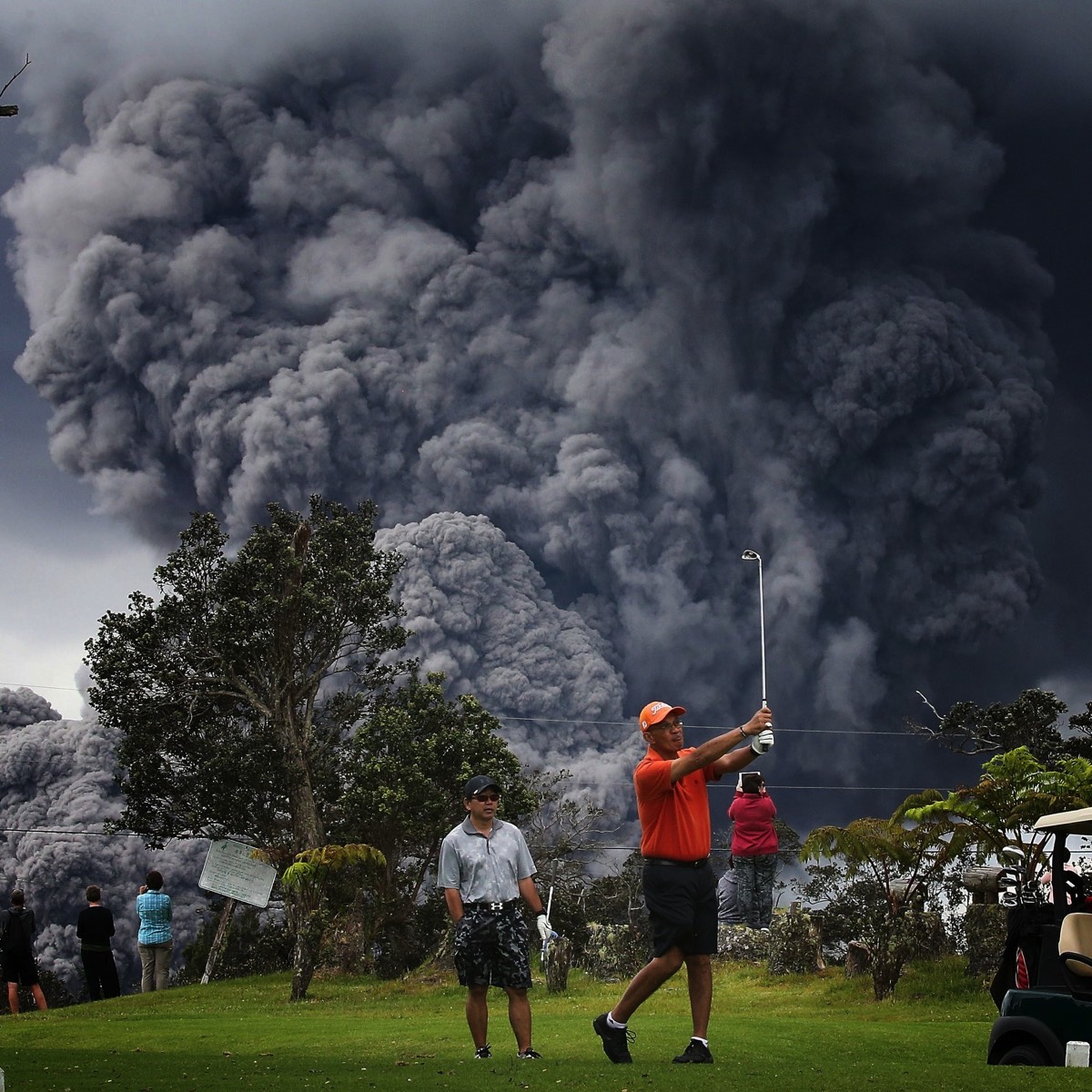
Explosion at the summit, May 15, 2018
Ok, maybe I should have stayed home that night and gone to the golf course that morning to see what might happen. It was obviously quite a spectacular thing to see and obviously didn't trouble these golfers or the spectators. That's the trouble with astrological predictions—astrological configurations cannot really tell us what exactly what will happen. But they can suggest what might happen, and when something does happen it correlates pretty darn well.
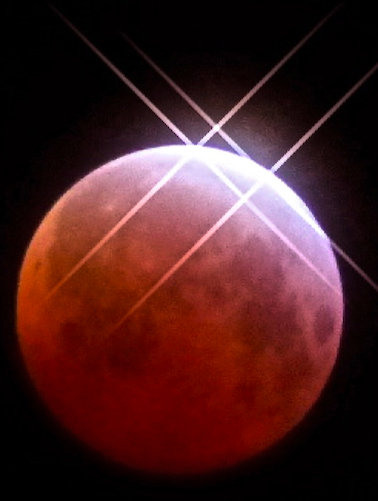
The blood moon lunar eclipse on April 4, 2015.
Taken at the summit of Kīlauea by John Casey
The Mars square Uranus configuration is usually something that last a few weeks. This time, however, it took place during a Mars retrograde period. The square was waning throughout the rest of May and June, but then on June 28 Mars stationed retrograde. Since then it has been backing up back into the square with Uranus. That is part of the reason why the lunar eclipse tomorrow is considered to be so potent. First of all, it is a total lunar eclipse with an especially long duration. It also occurs as the Moon is approaching perigee, its closest point to earth (August 10). The Moon at 04°44' Aquarius will be closely conjunct Mars at 03°58' Aquarius, and Mars will also be close to its perigee (July 30). One will be able to look up at the sky tonight and tomorrow night and see both the Moon and Mars bright and strong and quite close together. To top it all off, Uranus will be at 02°30' Taurus and thus closely square to both the Sun and the Mars/Uranus conjunction. That pattern with the Sun opposite Mars/Moon and square Uranus is known in astrology as a T-square. It is a most dynamic and powerful configuration. Mars square Uranus is an explosive aspect and lining up with this total lunar eclipse, suggests to astrologers that something pretty big is about to happen . . . somewhere.
Mars will exactly square Uranus again on August 1 at 02°32' Aquarius-Taurus. Uranus will station retrograde on August 7, Mars goes direct on August 27, and then squares Uranus again, for the final time in this cycle, on September 18 at 01°52' Aquarius-Taurus. Because this long duration Mars-Uranus square coincides so closely with this eruption, it seemed to me early on that it was likely not going last only a few short weeks. As the geologists are now saying, it could last several years, and this might be suggested astrologically because it coincides also so closely with the passage of Uranus into Taurus. Moving retrograde Uranus will reach 0°00' Taurus again on Nov 6 and move back into Aries for a couple months before crossing that 0°00' Taurus for the final pass this cycle on March 6, 2019. It will then remain in Taurus for another seven years.
I don't know what will happen, but I suspect there will be some significant development in this eruption of Kīlauea either tomorrow around the time of the eclipse (10:20 AM HST), or in the next few days. The dates I just mentioned when the Mars-Uranus square is exact again and when Uranus crosses that Aries-Taurus borderline might also be ones to carefully watch. Of course, there could be many other types of explosive eruptions around the world that would correlate with this configuration. We are already seeing many record heat temperatures this summer in the northern hemisphere. I would think Taurus would also have to be associated with earth's climate, and there is little doubt among climate scientists that the next few years are likely to bring shocking developments.
Climate Change and Lava Flows
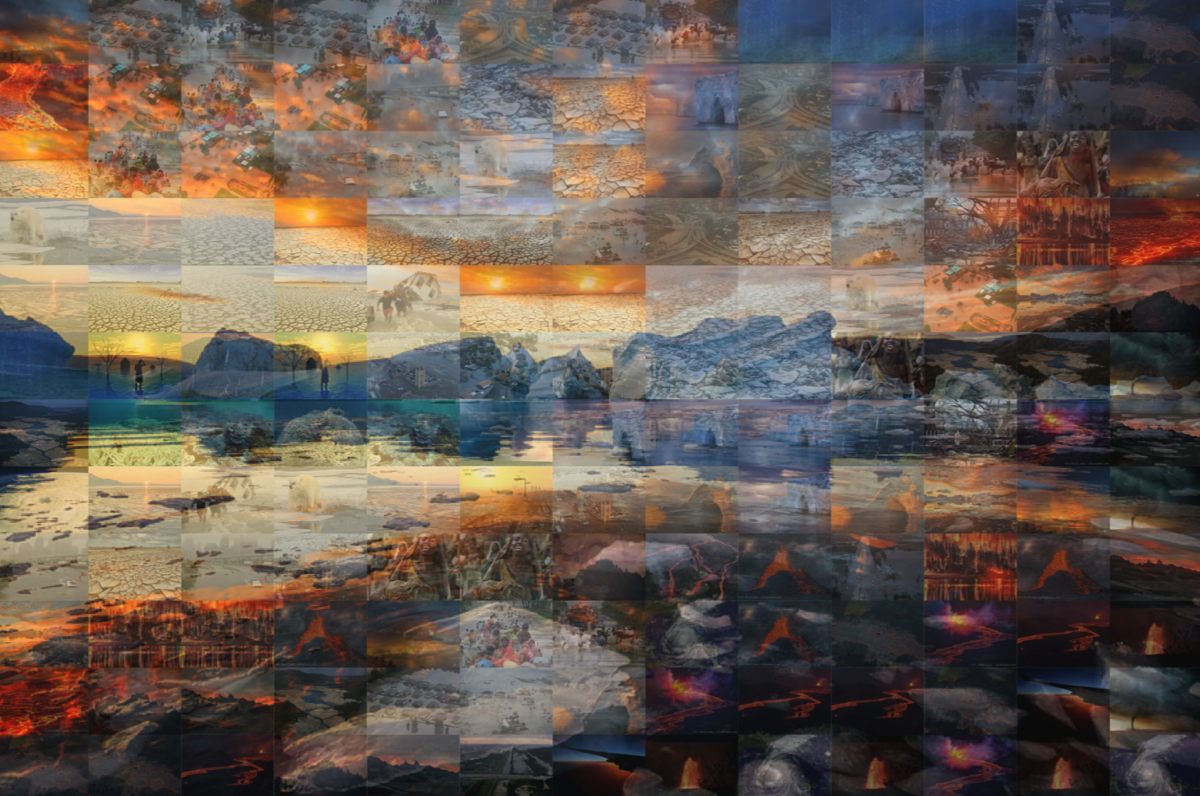
While this volcanic eruption has understandably dominated the news here on the Big Island lately, I keep thinking that, as sensational as these lava flows and the summit collapse have been, it is still nothing compared to the really big disaster, the problem of climate change, that all of us around the world are facing. Climate change is like the big lava flow that all of us are directly in the path of. A friend objected to this metaphor when I suggested it earlier, claiming that the two things are not similar since the lava flow is just nature doing its thing and climate change is due to human activity. Well I say to that you might as well tell Shakespeare that he is wrong and the world is not really a stage because we all aren't just acting out scripts or some other silly reason. I would say that the problem of climate change is just nature naturing too. When you put too much greenhouse gas into the atmosphere, this is just what happens. And the lava flow is also not without its human component. If they hadn't built neighborhoods in the east rift zone where eruptions had happened as recently as the 1950s, no one would be describing what is happening as a disaster or a tragedy. If the lava river were pouring through an uninhabited landscape it would just be a spectacle.
This volcanic eruption will one day finally end and nature will continue naturing and the blackened lava flows will once again become ground for tropical forests to bloom and new tidepools teaming with life will emerge from the scalded ocean entry points. We all know this is how the paradise of Hawaiʻi arose in the first place in the wake of Pele's wrath. But it is not at all certain that there will be any human beings around to enjoy it. We know that climate change is happening and it is due to human activity. There is a very strong scientific consensus about this. Once climate change passes the tipping point, however, there will no longer be anything humans can do to stop it. It will proceed with the same inevitability as a lava flow, only in this case there will be nowhere to go to escape it. Some say it is already too late and another mass extinction of life is already underway. If there is any hope we really must act now.
This is what Nietzsche was getting at in exhorting one to live dangerously. While the quote is pretty well known, most don't understand the point of it. Anyone familiar with Nietzsche's writings would understand that the injunction to 'build cities on the slopes of Vesuvius' is a metaphor. The volcano, of course, suggests fire, and Nietzsche uses a lot of fire imagery in Thus Spoke Zarathustra to suggest some kind of alchemical transformation. This connects with his intense focus on Dionysus throughout his career. Dionysus was the god in Greek myth and tragedy who brought about a transformation in those he touched through fire. Nietzsche thought the highest aim of art was its capacity to change us, and it was the Dionysian element in art that had this transformative power.
The broader context of the passage about living dangerously on the slopes of a volcano connects this passage with his reflection on the crisis facing humanity that is the main focus of Zarathustra's teaching. In a nutshell, Nietzsche thought that human civilization was heading toward an unparalleled crisis. This crisis, he thought, was the inevitable result of a way of being rooted in a longing for another world. This longing for another world frames a whole set of values that undermines life on earth. Let's face it, our whole civilization is not designed for a long-term sustainable future. Why would anyone even consider dealing with the problem posed by nuclear waste, for example, if one were considering the impacts for generations into the future? Why would one build a civilization that undermines the very ecosystem upon which all life depends? The whole thing seems to be built on the premise that the world is going to end soon anyway and that there is a better life to come in another world. Our whole manner of dwelling upon the earth seems based on the assumption that the earth is not really our home. We live on perhaps one of the most special planets in the whole universe, but human beings have yet to figure out how to live on it. Over 140 years ago Nietzsche diagnosed the problem and exhorted human beings to become 'loyal to the earth.' But this would require an overcoming, or further evolution, of humankind. That's what he meant by living dangerously. It is always difficult, and sometimes even dangerous, to embrace change; but the very future of humanity now depends upon our courage to face up to what it would mean to remain loyal to the earth. We simply must change the way we dwell upon the earth.
It takes courage to live on the slopes of a volcano. But you know what? It is not just us folks living on the slopes of Kilauea or other volcanoes around the world that are faced with that danger. In a sense, that is where we all are now.
